
1915-1920 NYC: The Evolution into a Cultural Hub and Architectural Marvel
From 1915 to 1920, New York City transformed dramatically, both in its physical landscape and cultural identity. This period, building on the architectural revolution of the previous years, saw the city’s skyline further enhanced by the Woolworth Building. Completed in 1913, it was not only an architectural marvel with its Gothic style and staggering height of 792 feet but also a symbol of the city’s economic might and ambition. This era marked the beginning of New York’s journey towards becoming a modern metropolis, defined by towering skyscrapers and architectural innovation.
Infrastructure development kept pace with architectural feats. The New York City subway, operational since 1904, continued its expansion in this period, integrating more neighborhoods and bolstering the growth of the outer boroughs. Advancements in road and bridge construction, especially the progress on the Manhattan Bridge, further improved the city’s physical connectivity. These developments were crucial in knitting together a rapidly growing and increasingly diverse city.
Culturally, this era was a renaissance period for New York City. The arts scene thrived, with Broadway becoming a global center for theater and performance. This cultural explosion was partly fueled by the city’s diverse population, enriched by continuous waves of immigration. New Yorkers from various backgrounds contributed to a vibrant cultural landscape that encompassed music, art, and literature. Social and cultural dynamism also led to significant social reform movements, addressing issues like women’s suffrage, labor rights, and the welfare of a burgeoning working class.
Economically, despite setbacks like the Panic of 1910-1911, New York City continued to expand its role as a financial and industrial hub. The economic challenges of this period, though less severe than the 1907 crisis, prompted a focus on addressing urban issues such as housing shortages and the need for improved public services. These challenges highlighted the complexities of managing rapid urban development. The period of 1915 to 1920 was thus a crucible of change for New York City, setting the foundations for its 20th-century status as a global metropolis. The city’s evolution during these years, marked by architectural, cultural, and economic shifts, was instrumental in shaping its modern identity.
Timeline of New York City’s History 1915-1920
Discover surprising historical facts about The City That Never Sleeps—explore fun, educational insights into its history, population, iconic landmarks, and more, perfect for students, history enthusiasts, and anyone curious about NYC’s rich heritage.
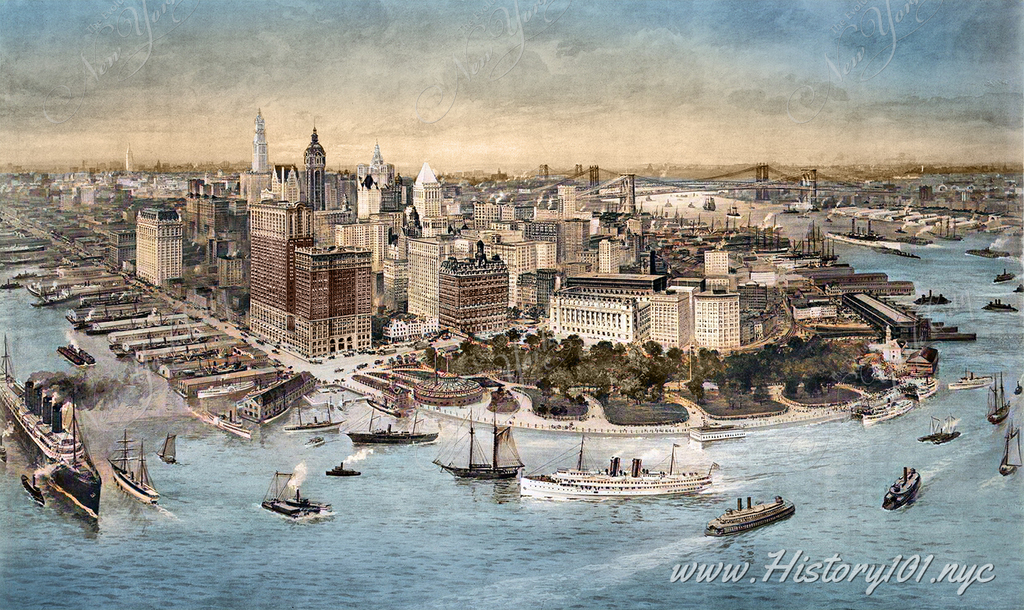
1915: Birds Eye View Lower Manhattan
An illustration depicting an elevated perspective of New York Harbor, buzzing with activity from many ships.
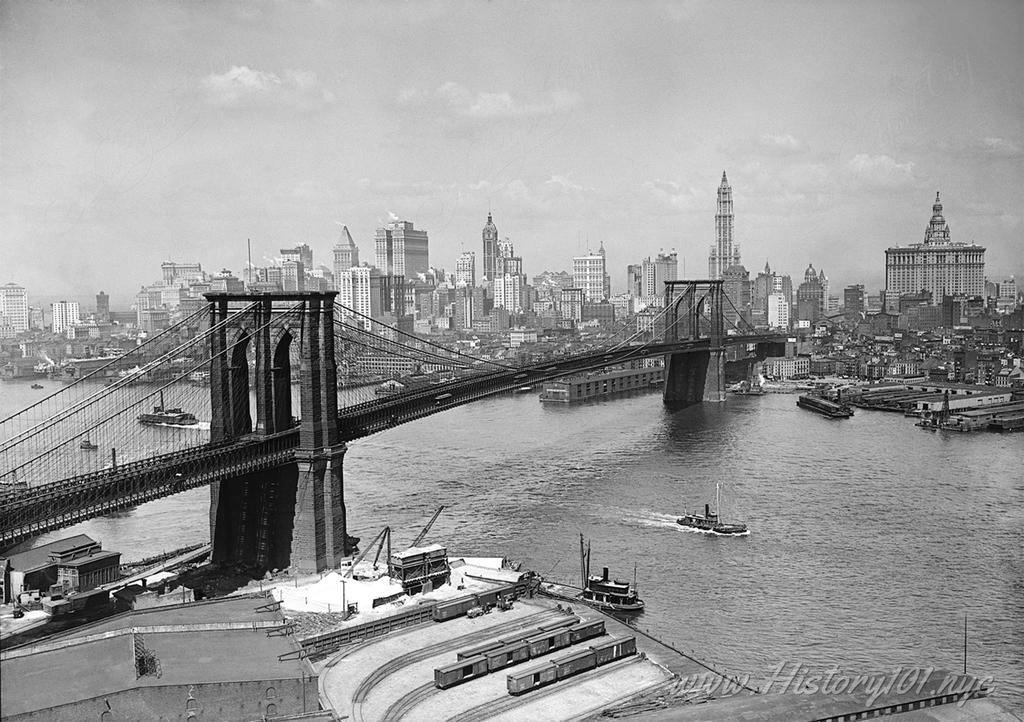
1915: Brooklyn Bridge
Aerial photograph of downtown Manhattan and Brooklyn Bridge spanning the East River.
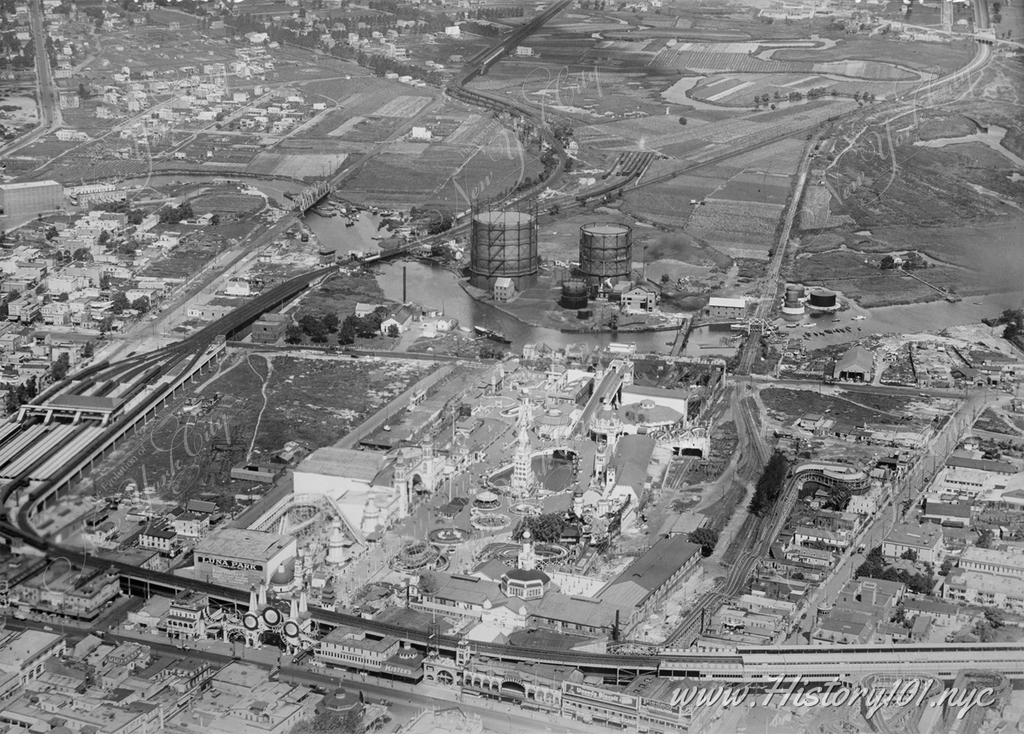
1915: Aerial View of Luna Park at Coney Island: A Journey Through Time
Explore Luna Park's transformation from its 1903 opening to its iconic status, through George Grantham Bain's lens. Witness Coney Island's evolution.
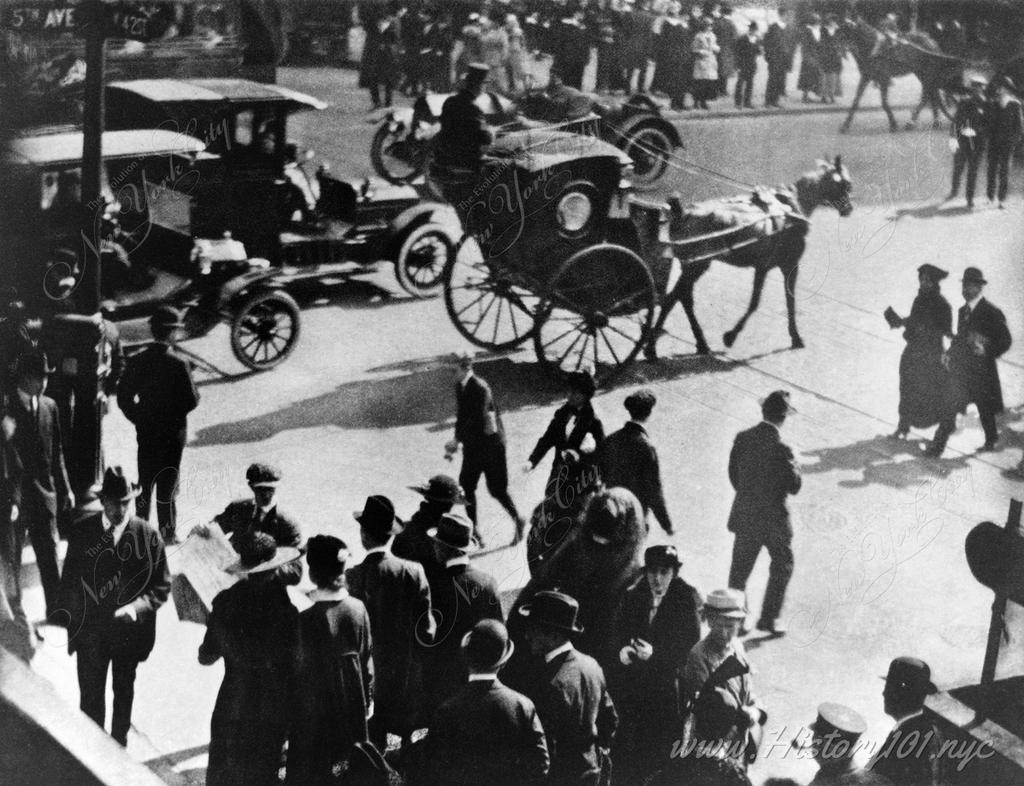
1916: Horse-Drawn Carriage and Automobiles
Photograph shows a horse-drawn carriage and automobiles on a city street in strong sunlight.
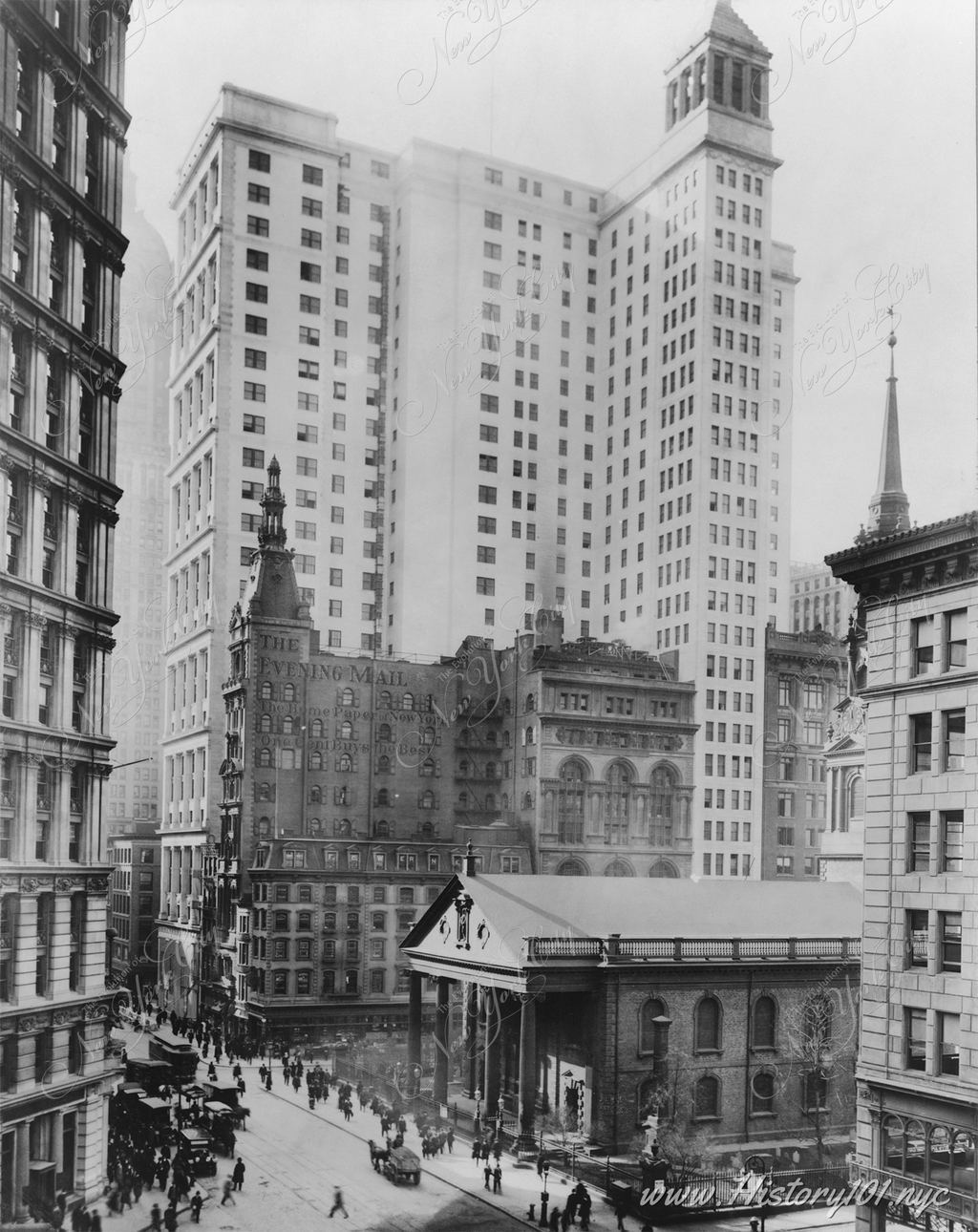
1916: Telephone and Telegraph Building
Photograph of the corner of Broadway and Fulton Street. The Telephone and Telegraph Building was designed by architect William Welles Bosworth and opened in 1916.
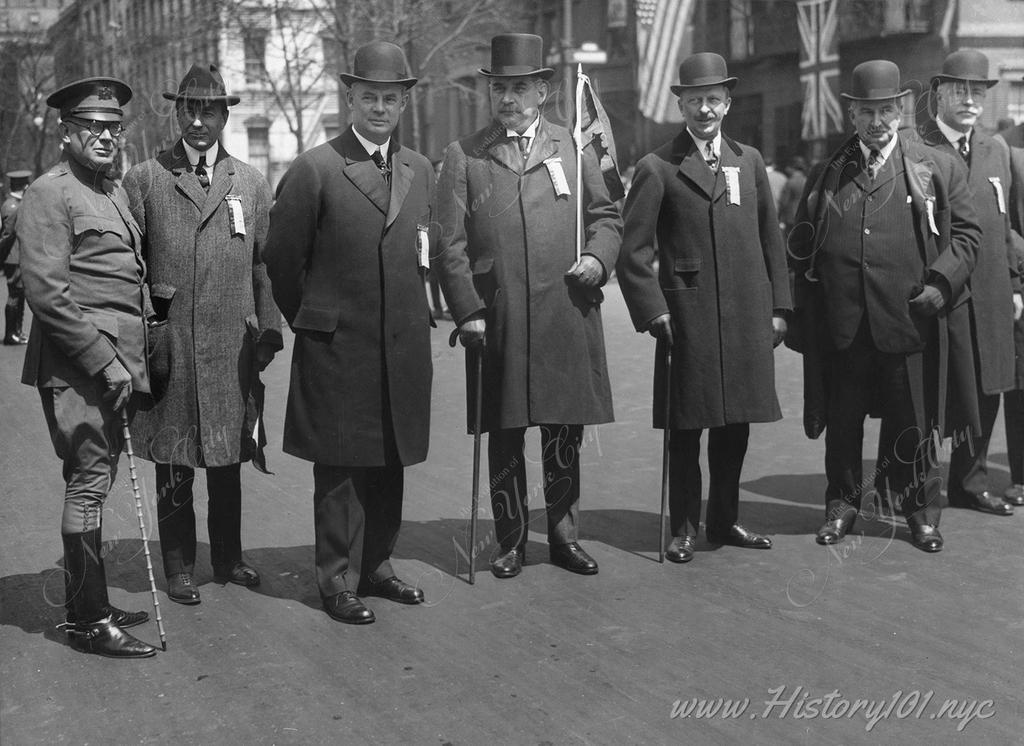
1918: Multi-Millionaires March in Liberty Loan Parade
General George R. Dyer, Benjamin Strong, Seward Prosser, J.P. Morgan, Charles H. Sabin, Gates McGarrah and Frank A. Venderlip at NYC's 3rd Liberty Loan Parade.
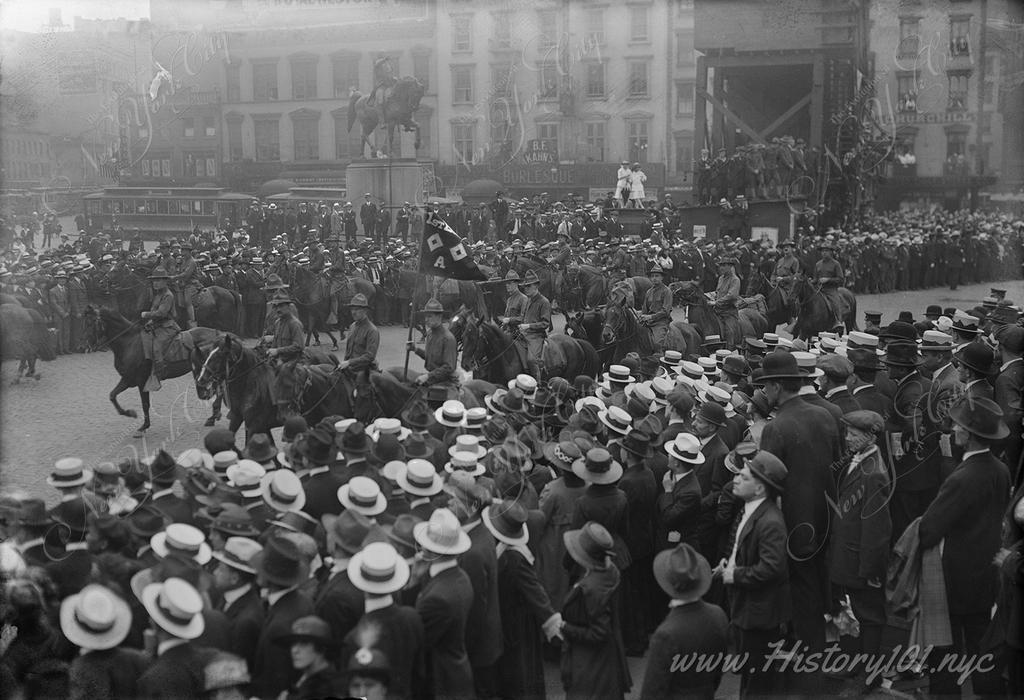
1917: World War I-Recruiting Parade
Photograph of military procession at Union Square drumming up support and enlistments for World War 1.
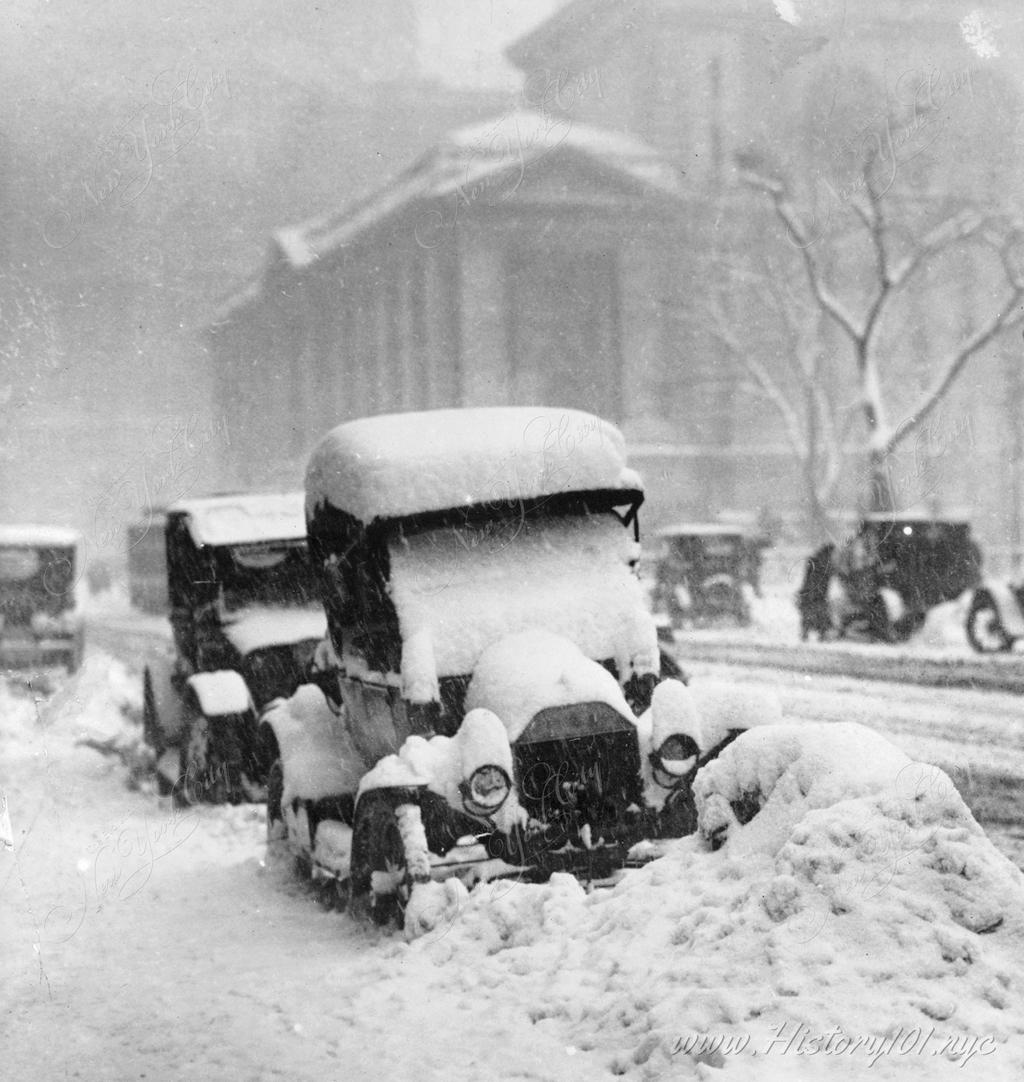
1917: Snowbound Automobiles
Photograph of parked cars, locked in place by piles of snow after a blizzard.
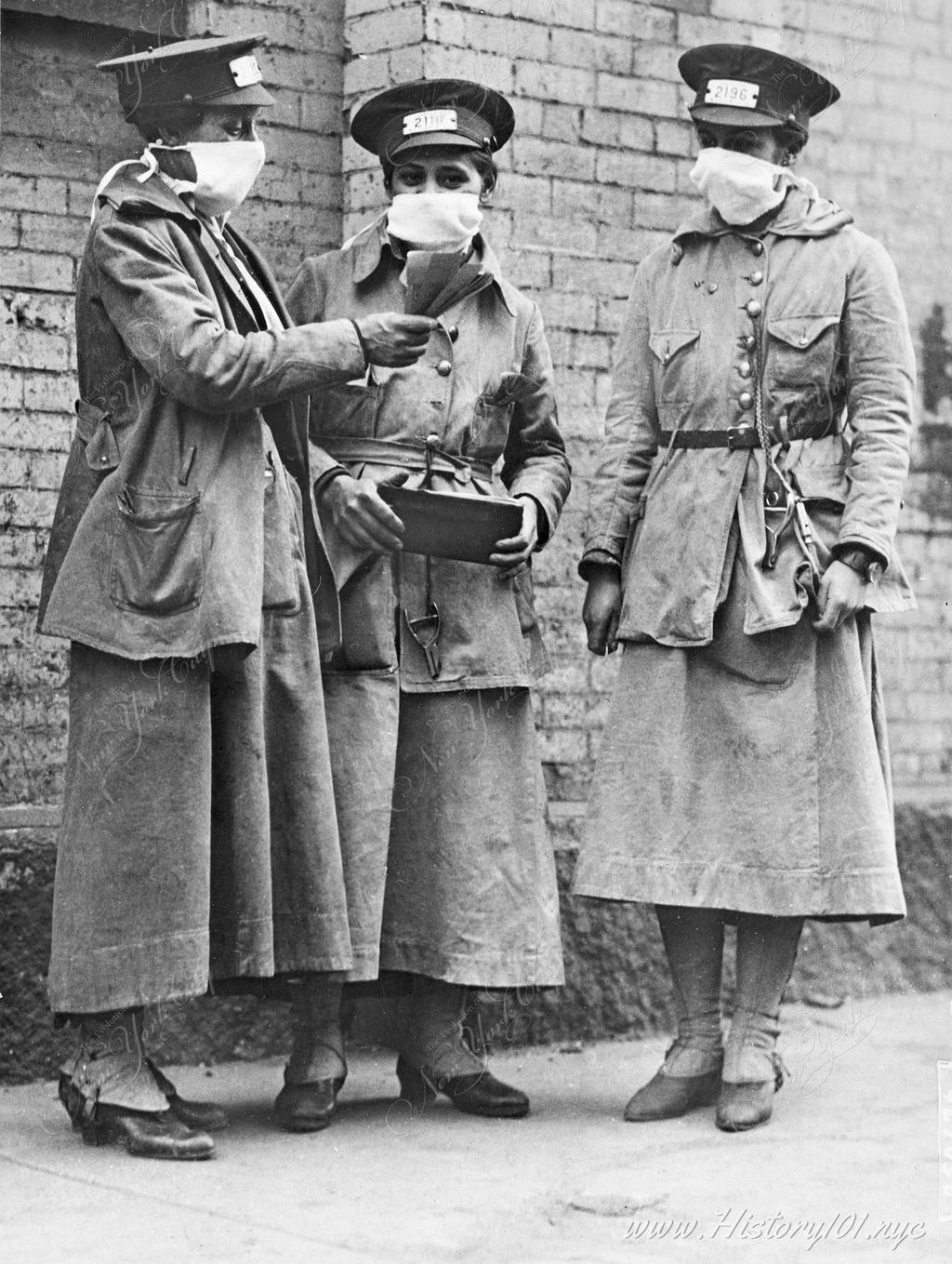
1918: Conductorettes Wearing Masks During Pandemic
Photograph of female transit workers wearing face masks for protection from the highly contagious and deadly flu which was spread far and wide by the war.
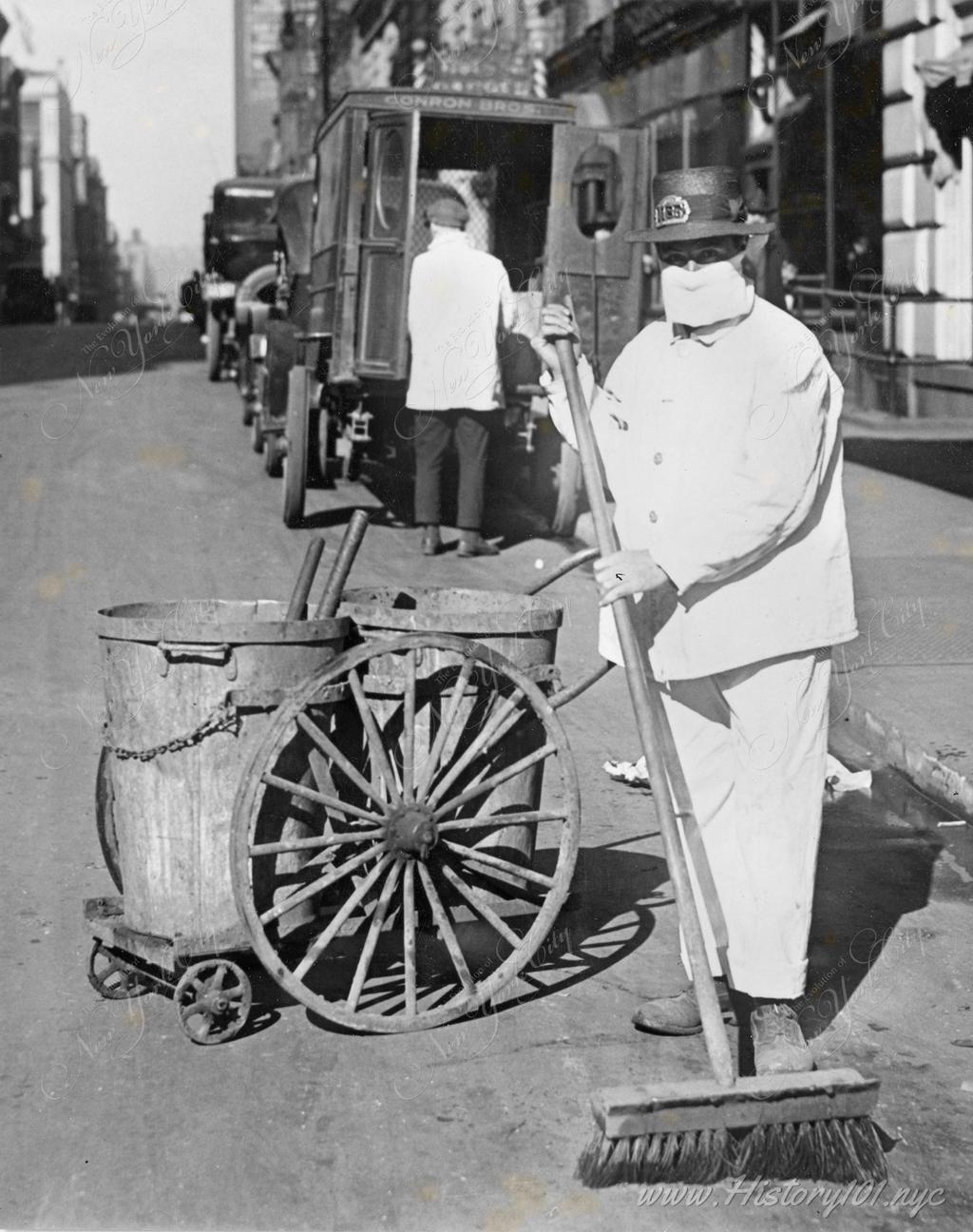
1918: Influenza Epidemic - Street Cleaner Wearing Mask
Mask worn by a street cleaner to check influenza spread. The catch phrase of the New York Health Board to wear masks has been headed: "Better ridiculous than dead"
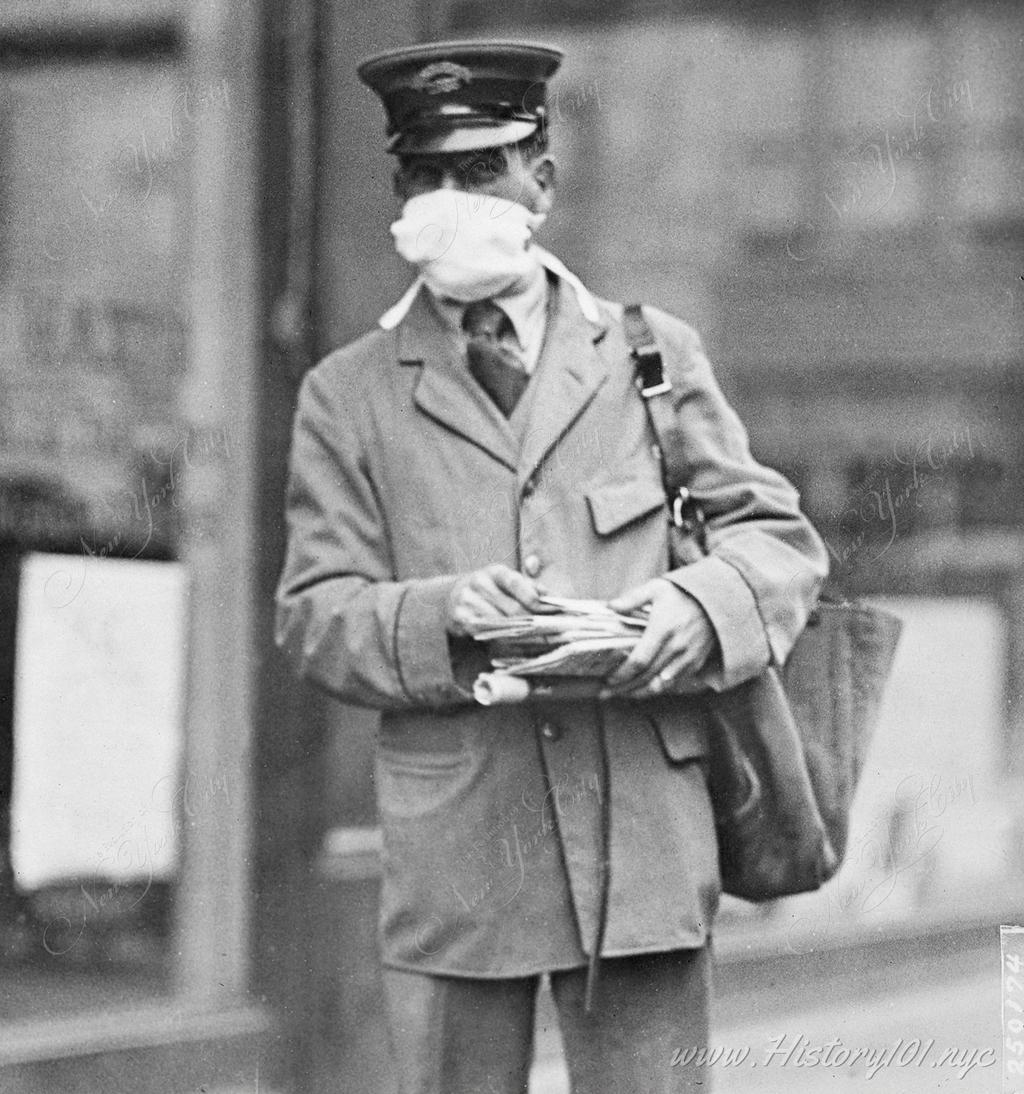
1918: Influenza Epidemic - Letter Carrier Wearing Mask
Photograph of a mailman wearing a face mask during the deadly avian flu which was sweeping the world.
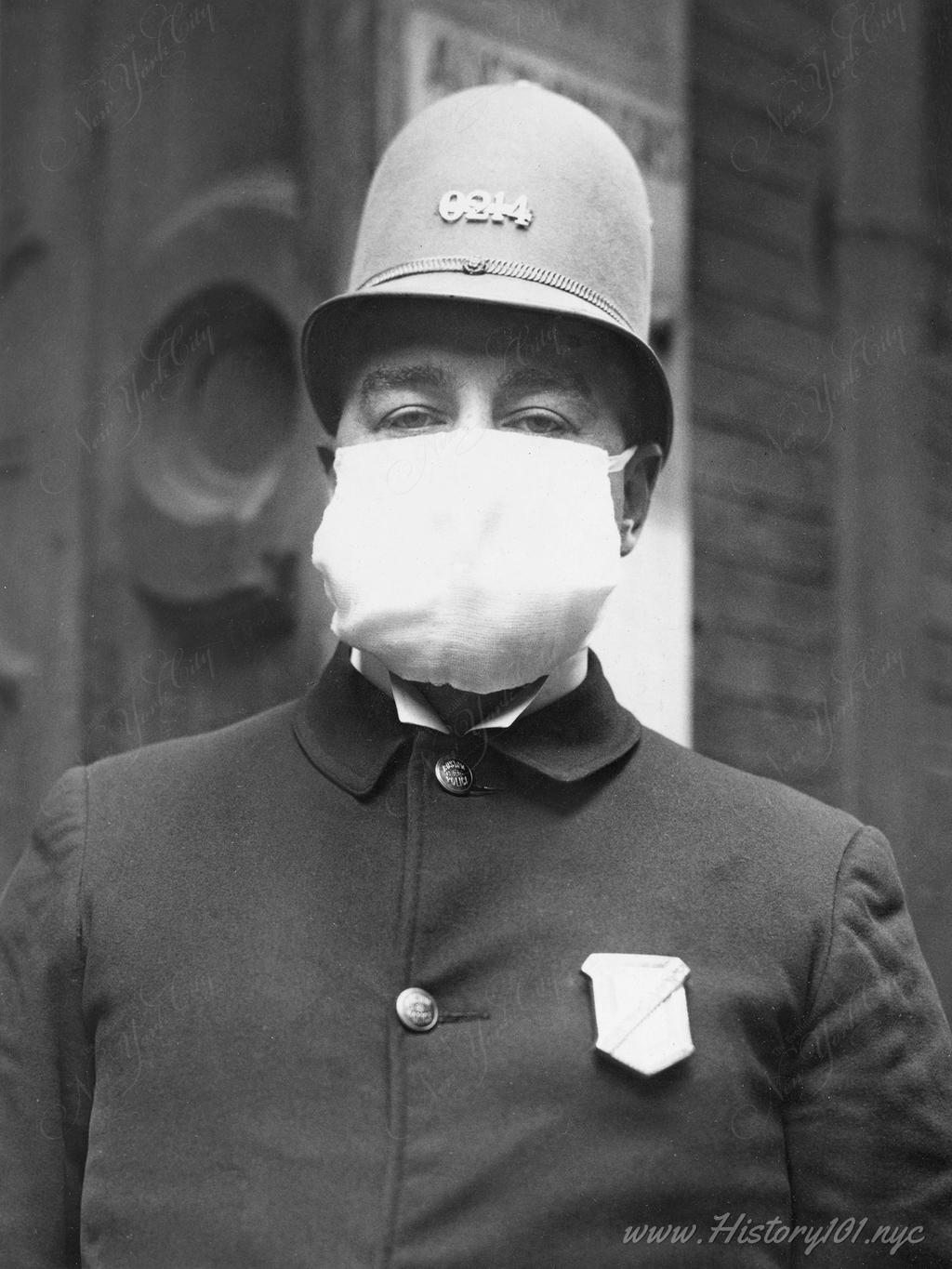
1918: Influenza Epidemic - Policeman Wearing a Mask
Photograph of a policeman wearing a mask during the Spanish Flu pandemic. 1700 of these masks were distributed to police throughout the city for protection.
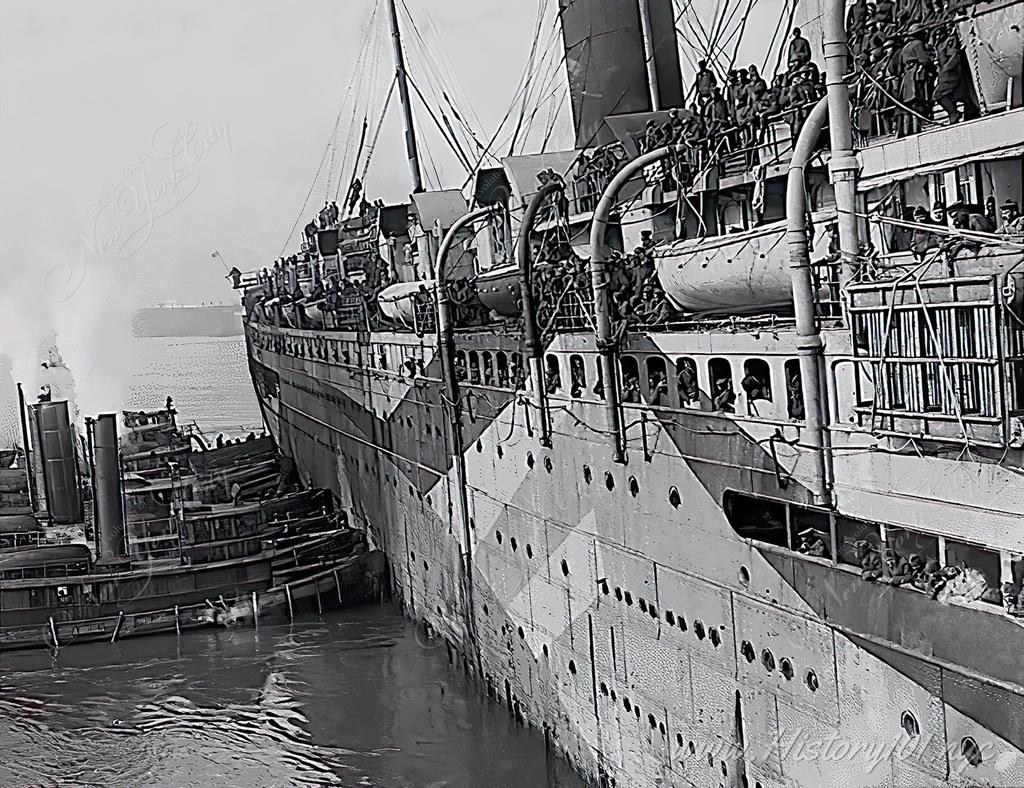
1918: 369th Infantry on the Transport Decks
Photograph of the famous African American regiment arriving home - they never had one of their men captured, and received the Croix de Guerre for their bravery.
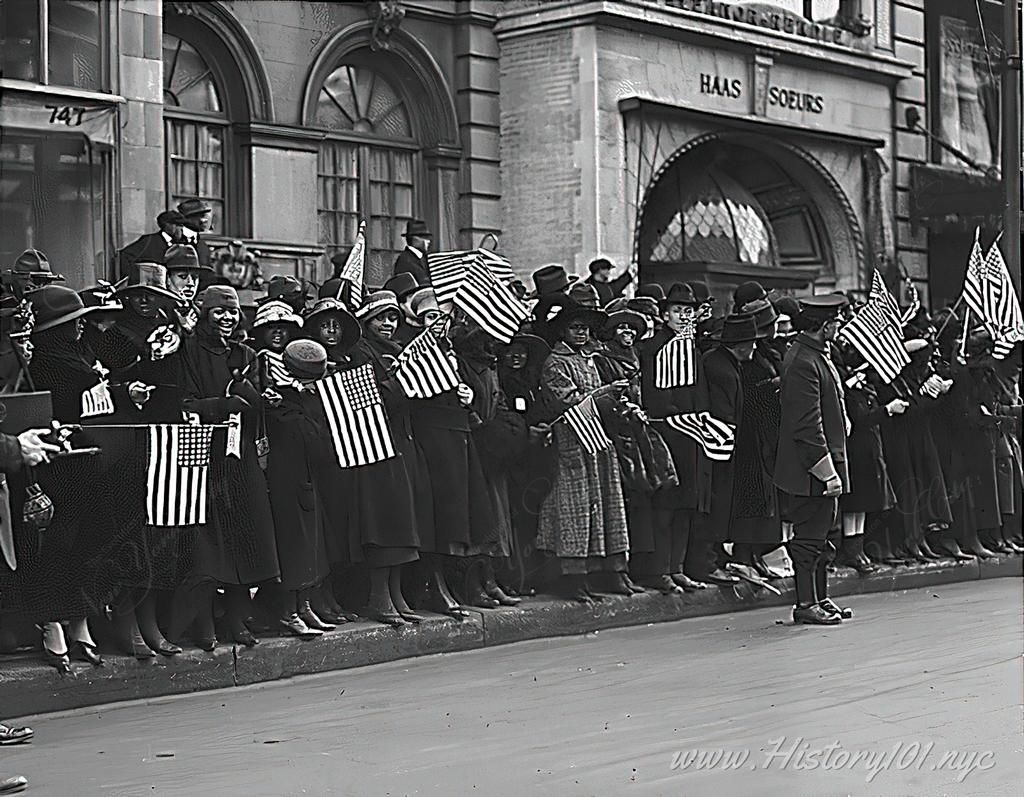
1918: Crowds at Parade of the Famous 369th Infantry
Photograph of crowds waiting for the parade of the famous 369th Infantry (Harlem Hellfighters).
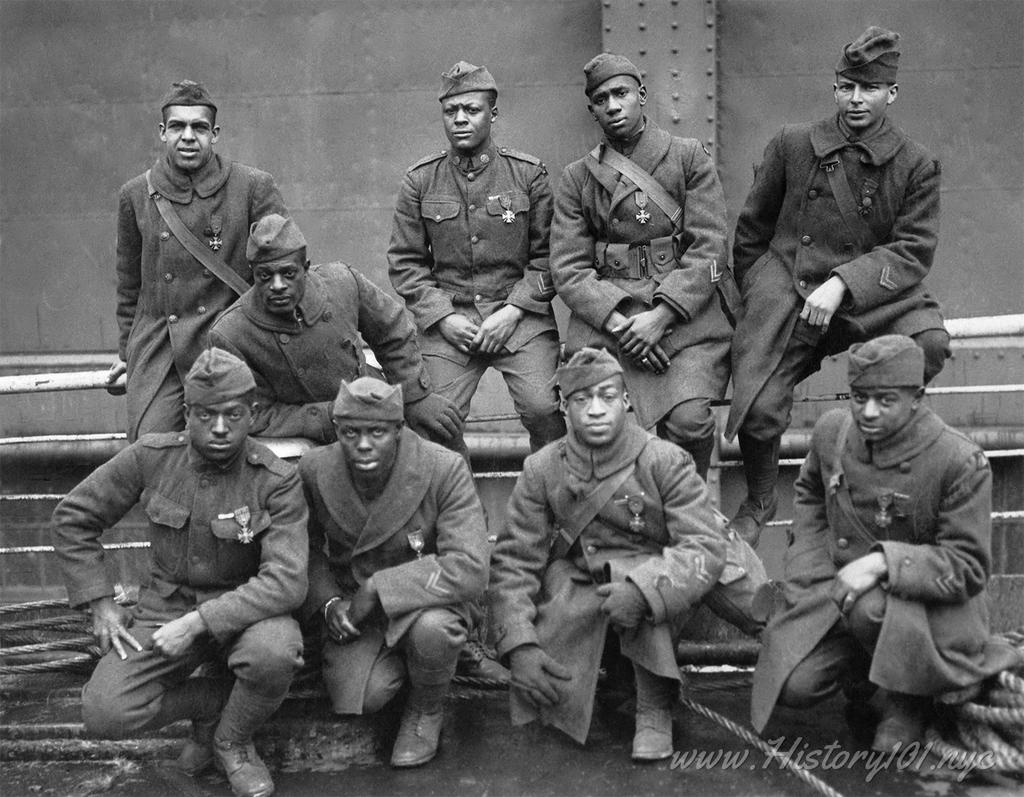
1919: 369th Infantry
Some of the men of the 369th Infantry Regiment (aka Harlem Hellfighters) who won the Croix de Guerre for gallantry in action.
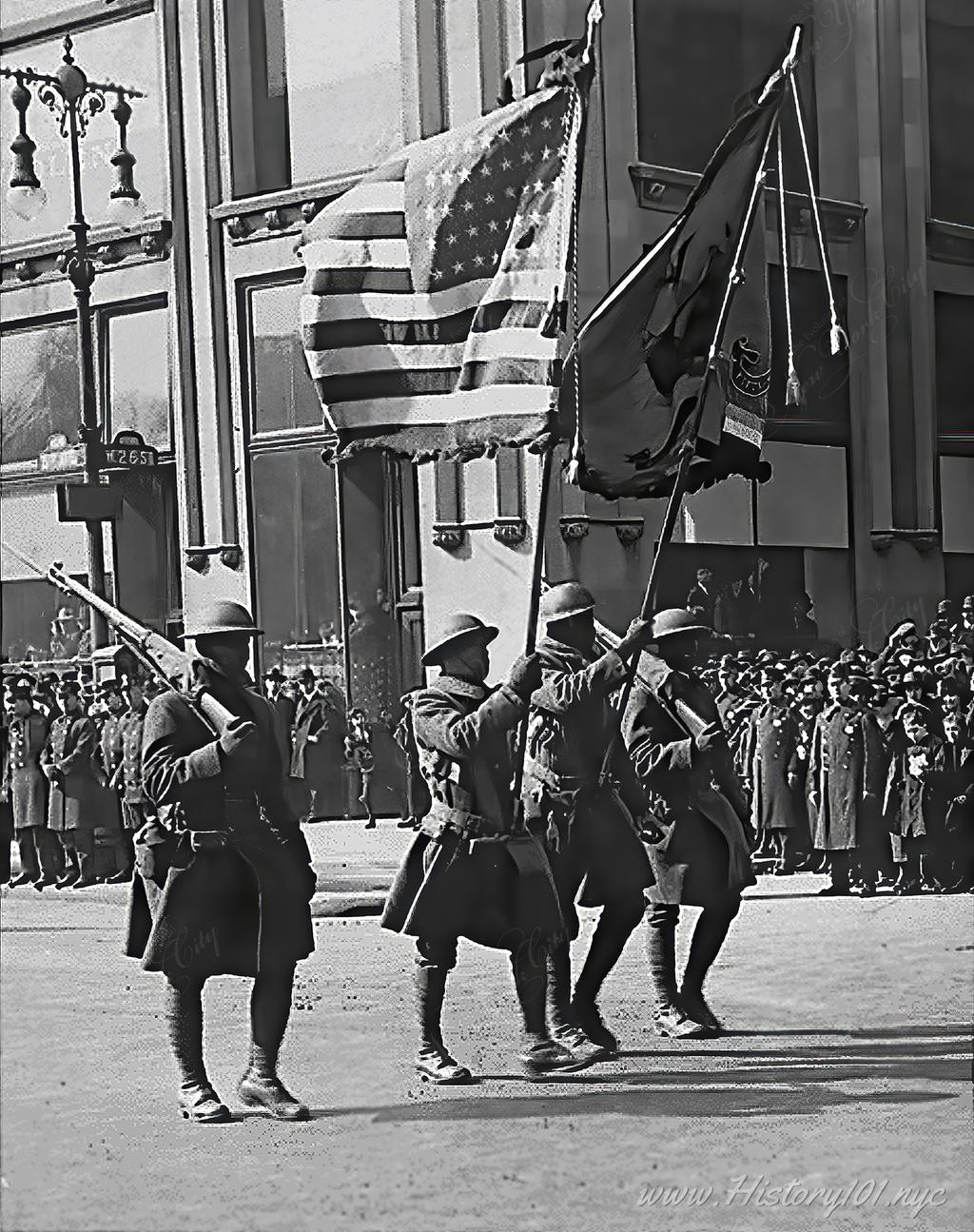
1918: Colors of the 369th Infantry
Photograph of the 369th Infantry, commonly referred to as "The Harlem Hellfighters" waving an American flag and their infantry colors.
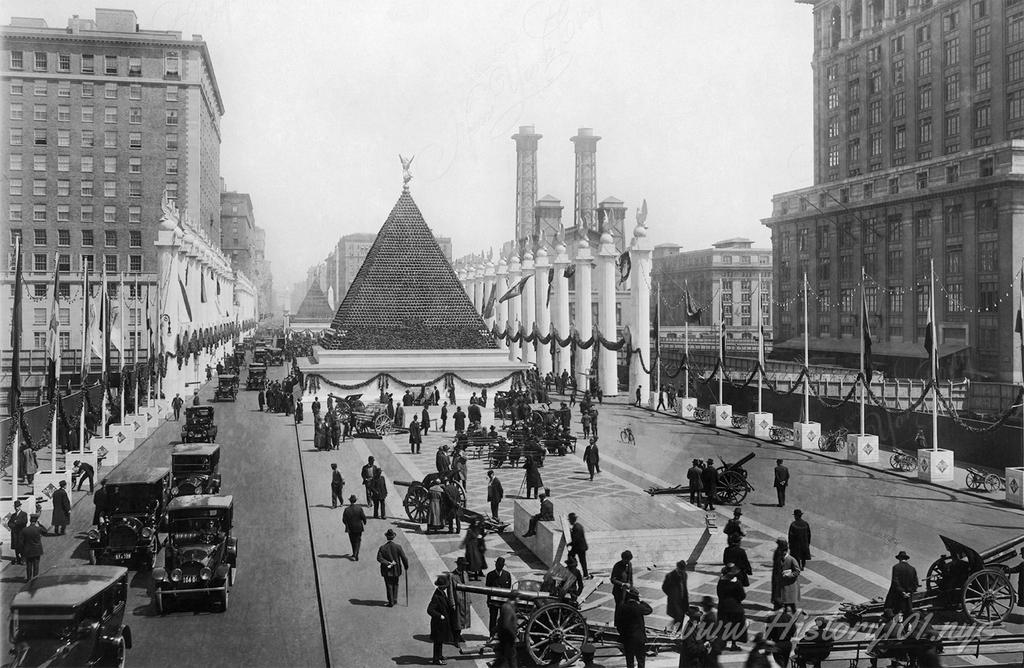
1919: Victory Way on Park Avenue
Aerial photograph of Victory Way on Park Avenue, showing two pyramids that were covered in German helmets to celebrate Allied victory in the Great War (WW1).
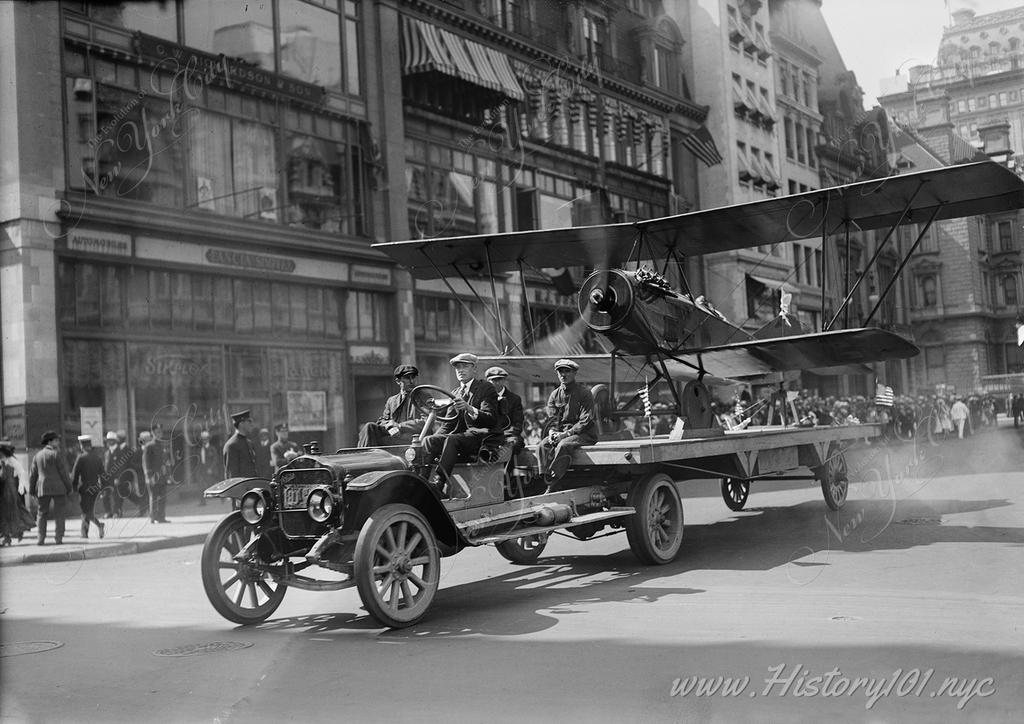
1918: July Parade on 58th Street and Fifth Avenue
Photograph shows a Fourth of July parade on Fifth Avenue, New York City in 1918 with a Curtiss bombing plane mounted on a truck.
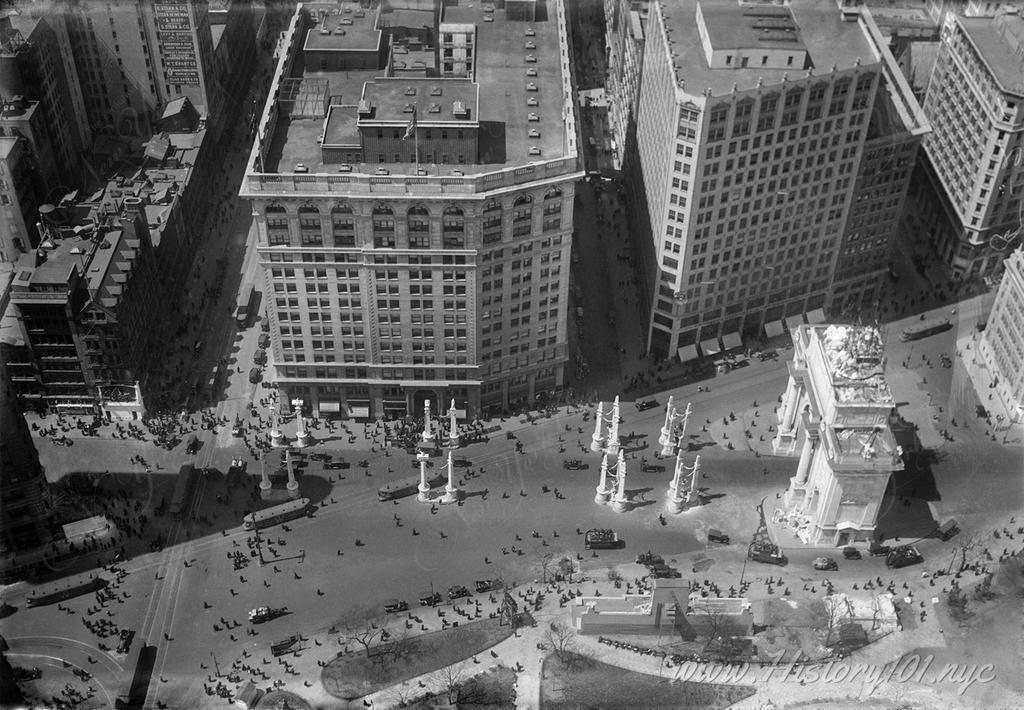
1918: Madison Square Victory Arch
Aerial photograph of the temporary "Victory Arch" at Madison Square. Also pictured is the Metropolitan Life Insurance Company Tower at 24th Street and 5th Avenue in the Flatiron District of Manhattan.
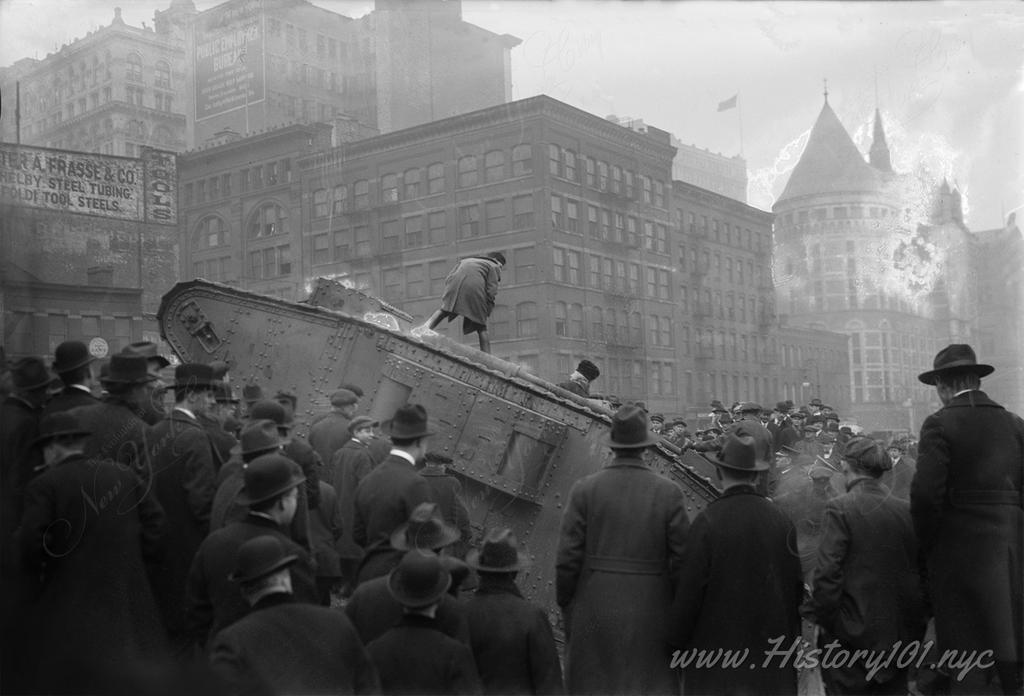
1918: New York Court House Excavation
Photograph shows the British tank Britannia at the construction site of the courthouse behind the Municipal Building.
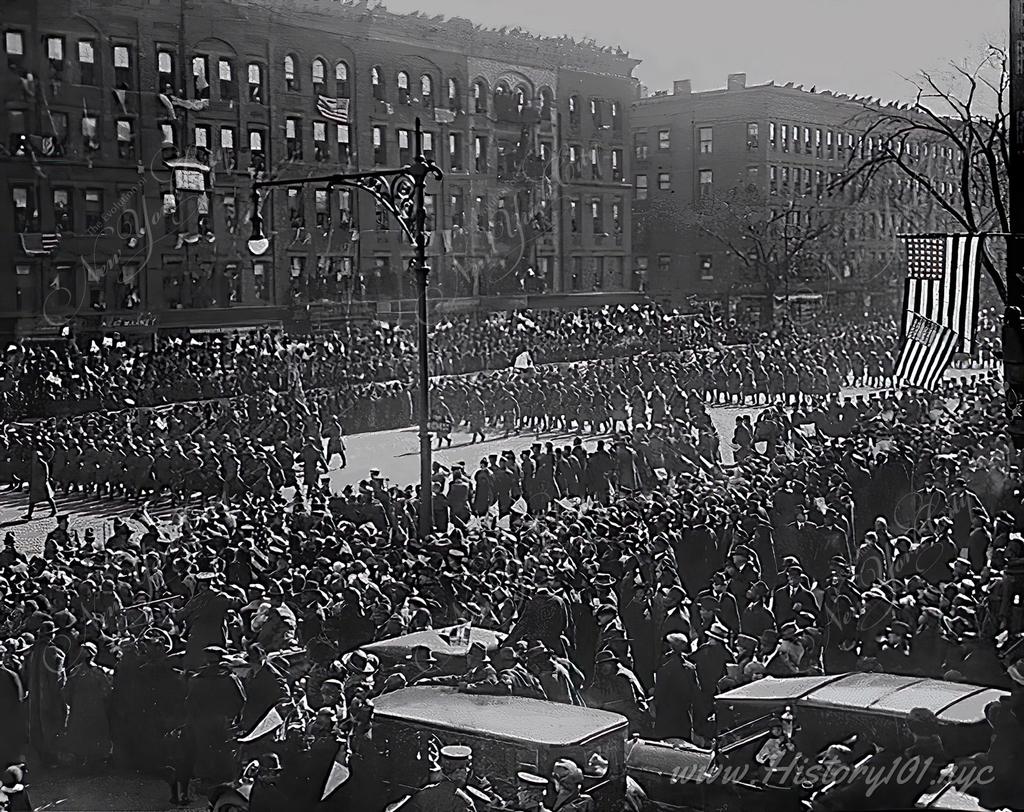
1918: 369th Infantry Return Home
Photograph of a parade held in honor of the 369th Infantry upon their victorious return home.
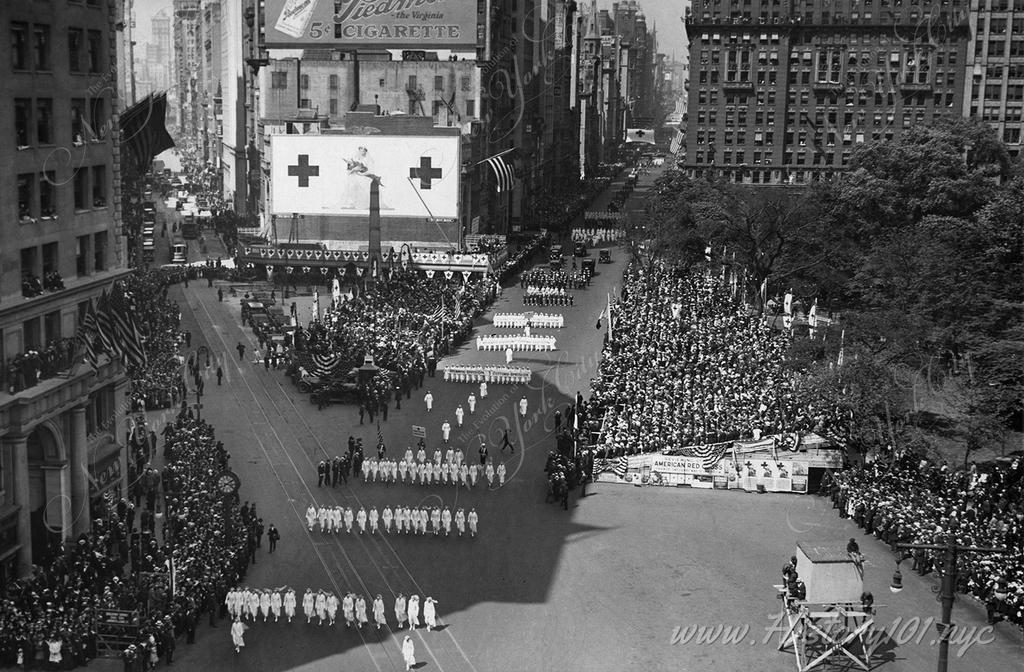
1918: Madison Square Park - Red Cross Parade
Photograph of the Red Cross Parade being reviewed by President Wilson at junction of Broadway and Fifth Avenue.
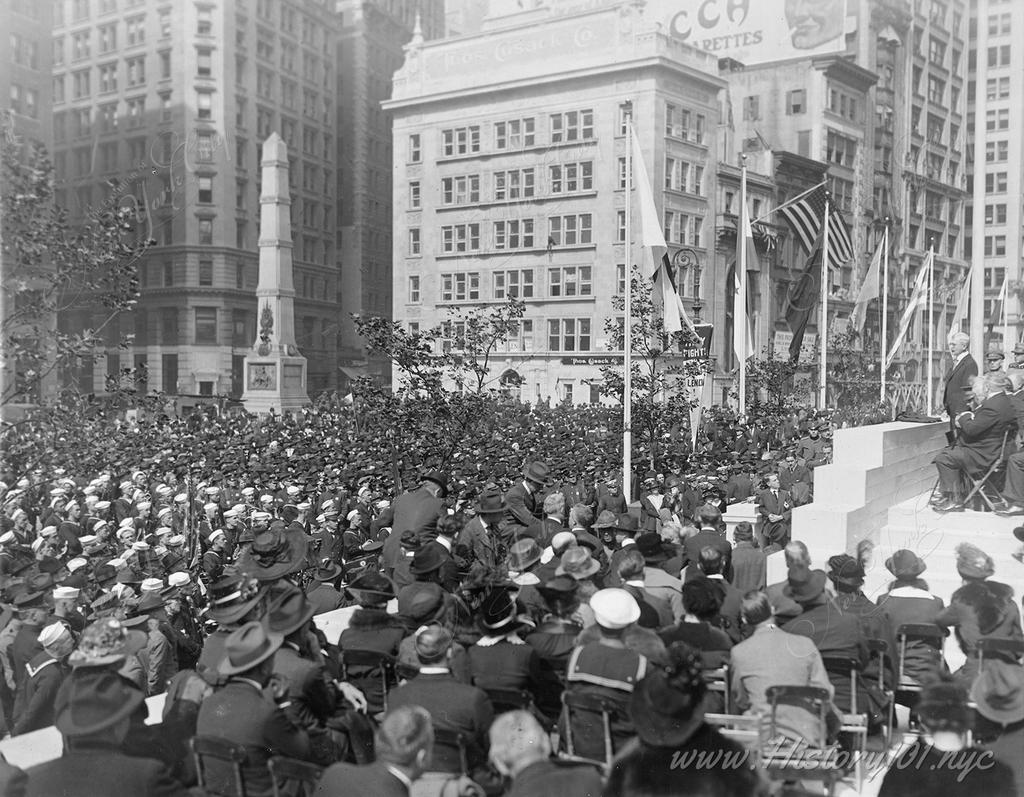
1918: Vice President Marshall Makes Liberty Loan Speech
Vice President Thomas R. Marshall speaking for the 4th Liberty Loan at the Altar of Liberty in Madison Square on the opening day of the drive.
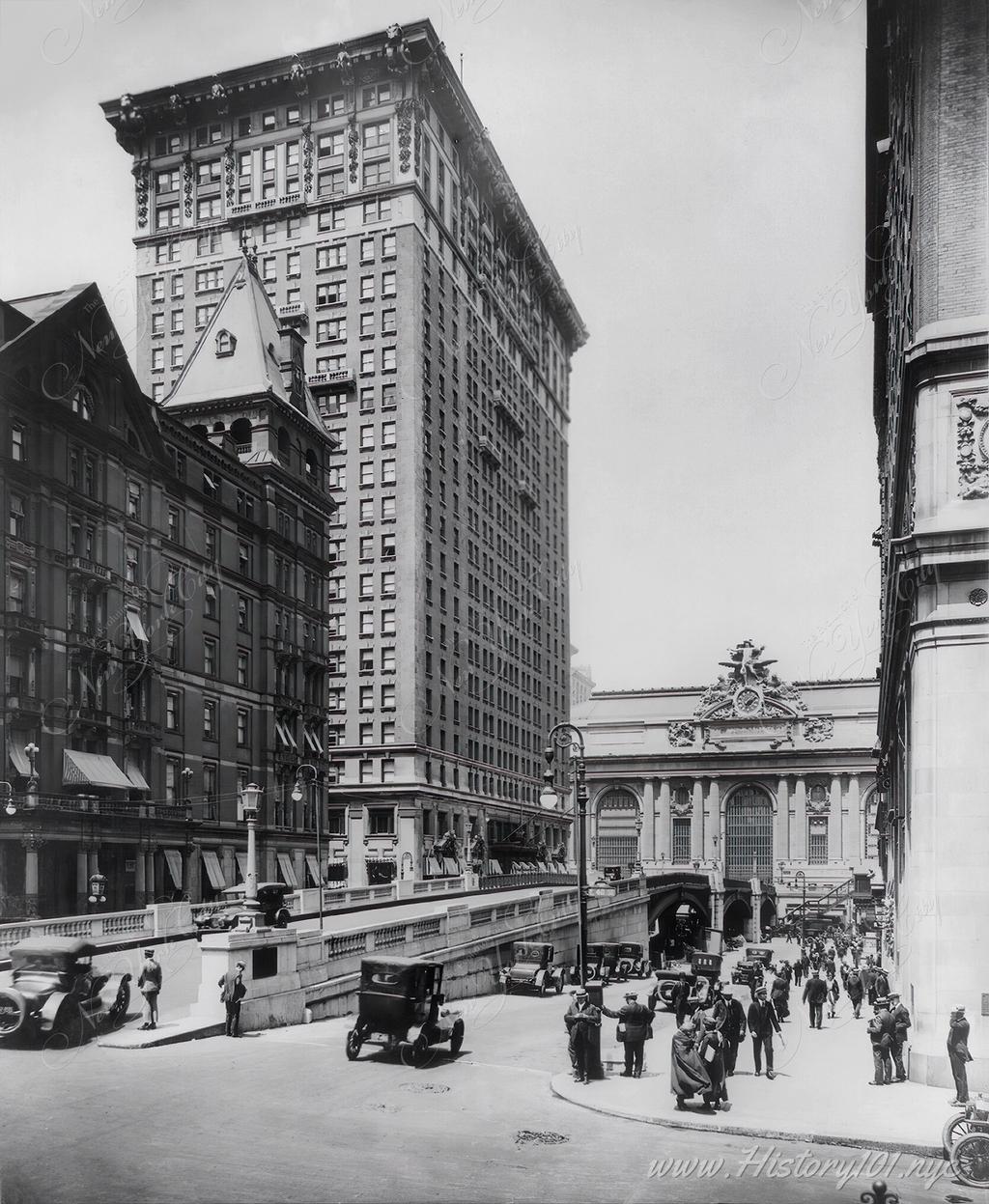
1919: Grand Central Station
Photograph of Grand Central Station with the Park Avenue Bridge in foreground and the Station's facade in background.
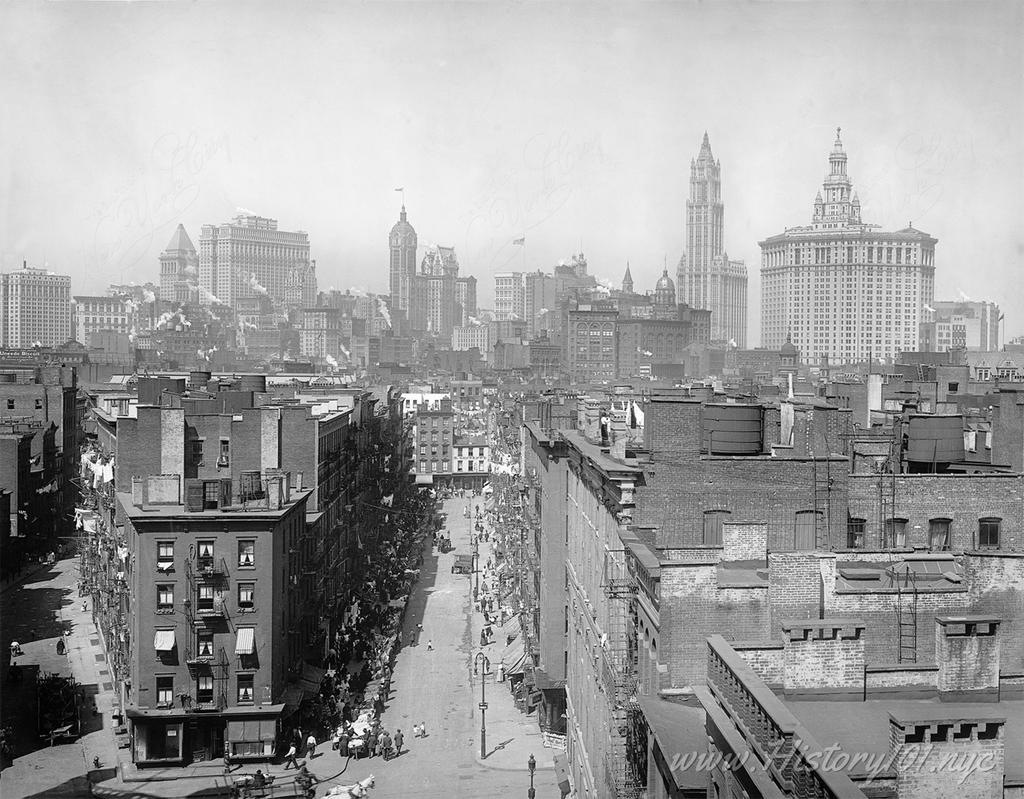
1915: Manhattan Bridge View: Capturing New York City's Skyline Evolution
Discover the 1915 skyline of NYC through a historic photograph from the Manhattan Bridge, depicting the city's architectural transformation
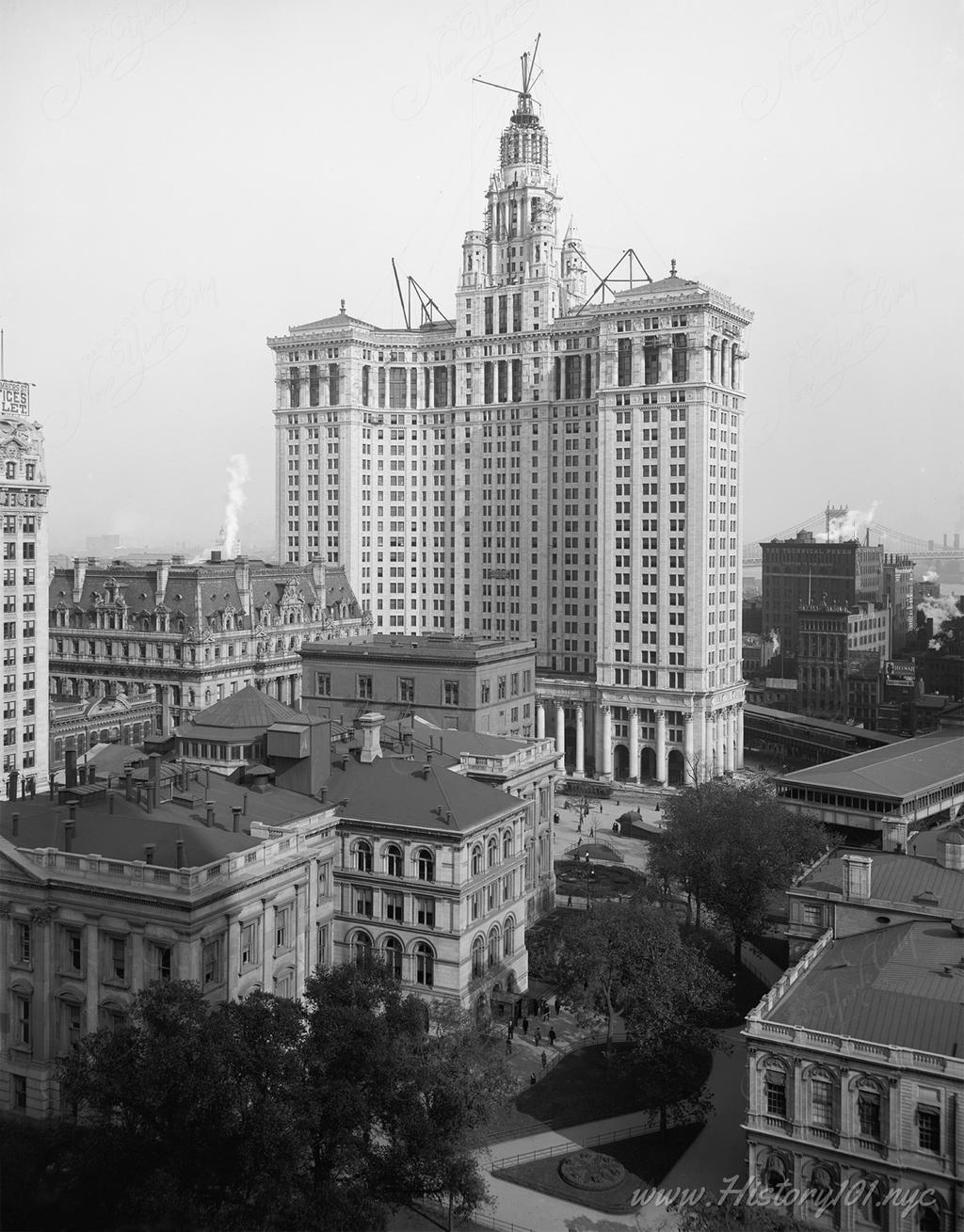
1915: Municipal Building
Aerial photograph of the new Municipal Building in its final phases of construction.
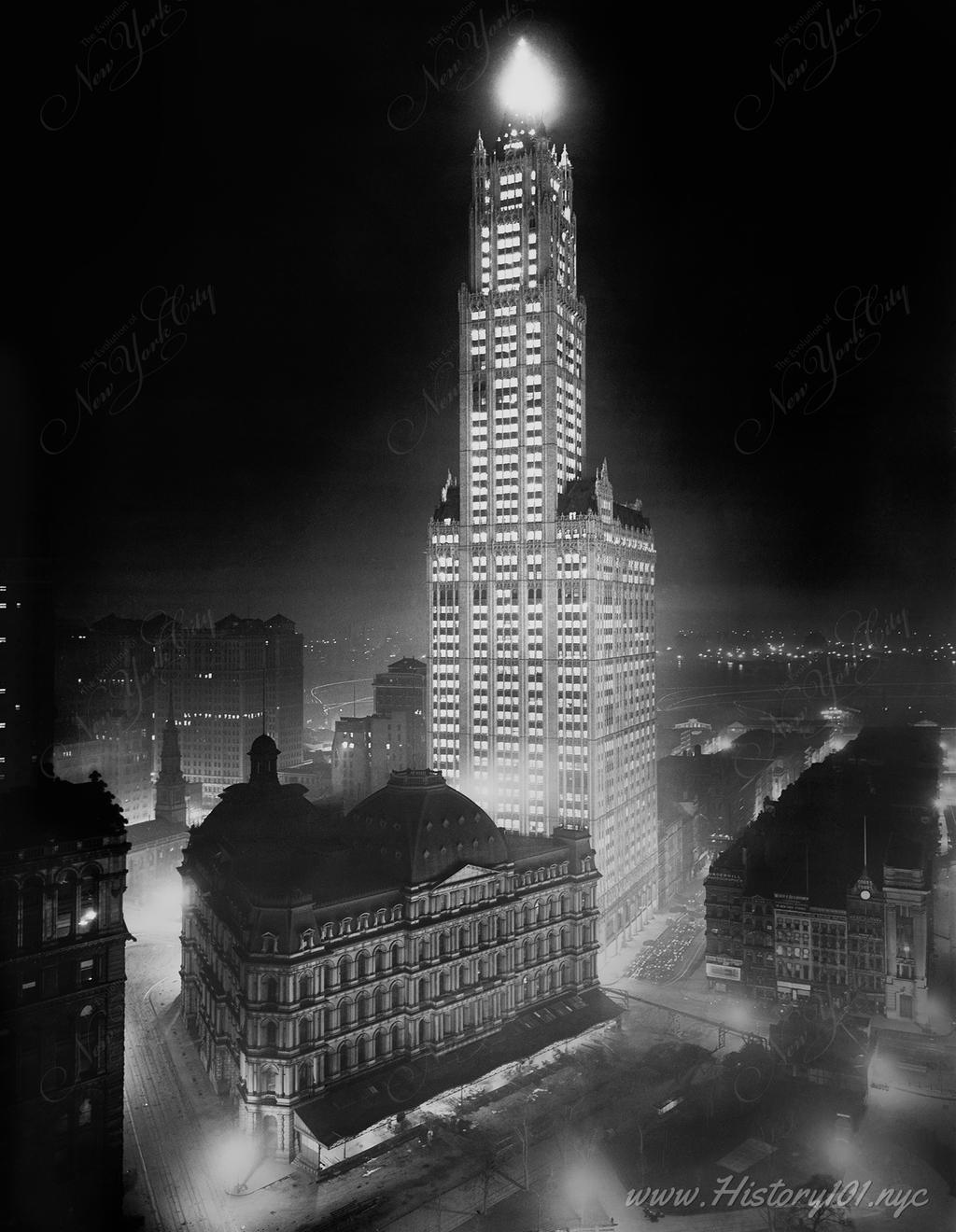
1915: Woolworth Building at Night
Photograph of the Woolworth Building and surrounding streets bathed in the artificial light of the city that never sleeps.
Timeline of New York City: 1915-1920
1915: Midway between the two census years of 1910 and 1920, New York City was undergoing rapid growth, reflected in the estimated populations calculated through linear interpolation. New York City’s total population was approximately 5,193,466. This surge in residents was evident across its boroughs: the Bronx saw its numbers rise to about 581,498, Brooklyn expanded to approximately 1,826,354, Manhattan’s population was roughly 2,307,823, Queens grew to about 376,542, and Staten Island’s population reached around 101,250. The city’s growth was influenced by its economic opportunities and status as a cultural melting pot, attracting both immigrants and migrants from across the United States.
The early 20th century marked a period of significant urban transformation for New York City, influenced by industrialization and the influx of immigrants, contributing to its demographic changes. From the 1910 total of 4,766,883, the city’s population had climbed to 5,620,048 by 1920, with each borough experiencing its own unique growth trajectory. This era also witnessed the expansion of infrastructure and housing to accommodate the burgeoning population, shaping New York City’s development into a modern metropolis known for its diverse population and dynamic urban landscape.
1915: On April 6, New York City adopted its first official flag. The design was a tricolor of blue, white, and orange, reflecting the city's Dutch origins and aligning with the colors of the flag of the United Netherlands from 1625. The city seal, placed in the center of the white stripe, was a simplified version of the city's seal without the Latin legend, creating a visual link to the city's historical roots. Before this, New York City utilized an unofficial flag featuring the city seal in blue on a plain white field, but the design marked the first formal recognition of an official municipal flag.
The flag was officially unveiled to the public later that year on June 24, symbolizing a new era of civic pride and municipal identity. The colors and design of the flag have remained largely consistent to the present day, with minor modifications, the most notable of which occurred on December 30, 1977. This update altered the seal to change the date from 1664, marking the English takeover, to 1625, to emphasize the city’s Dutch origins, reflecting a broader appreciation of New York's complex colonial history. This change was spearheaded by Paul O'Dwyer, then president of the City Council, highlighting ongoing debates about the city's founding date and its historical narrative.
1915: New York State held a Constitutional Convention with ambitious aims to overhaul its governance structure. The convention proposed a new constitution featuring 33 recommendations, including consolidating state government departments, streamlining state financing, and defining the executive's role in the state budget process. However, when these proposals were presented to the voters as a complete package rather than as individual amendments, they were decisively rejected by more than a two-to-one margin in a statewide referendum. This outcome was largely due to the reluctance of voters to approve the entire document without the ability to consider each amendment on its merits.
Despite the initial rejection, most of the recommendations from the convention were eventually adopted in subsequent years as individual amendments to the existing constitution. This piecemeal approach allowed voters to assess each change separately, leading to greater acceptance over time. The convention remains a significant event in New York's legislative history, reflecting both the challenges and possibilities of constitutional reform. The last Constitutional Convention in New York took place in 1967, and subsequent proposals to convene another convention were voted down in 1977, 1997, and 2017, indicating a continued wariness among New Yorkers regarding comprehensive constitutional changes.
1915: Billie Holiday, though not born in New York City, is often regarded as a quintessential New Yorker due to her significant impact on the city's jazz scene. Born Eleanora Fagan on April 7, in Philadelphia, Pennsylvania, Holiday moved to New York with her mother, Sarah Julia "Sadie" Fagan, in 1929. She launched her legendary singing career in Harlem's vibrant nightclub scene, adopting her stage name from actress Billie Dove. Her career, which spanned the 1930s to the 1950s, was marked by a unique vocal style that transformed the phrasing and emotional depth of the songs she performed.
Regardless of personal challenges, including being abandoned by her father, Clarence Halliday, shortly after her birth, Holiday rose to fame with her expressive voice and emotive performances. She passed away on July 17, 1959, in New York City and was buried in Saint Raymond's Cemetery in the Bronx, solidifying her status as an iconic figure in New York's cultural history. Billie Holiday's musical legacy continues to influence artists across various genres, and her life and contributions to music have been extensively chronicled in books and films.
1915: The 42nd Street–Grand Central station on the IRT Flushing Line, also known as the Grand Central–42nd Street station, officially opened on June 22. This key transit hub is located beneath Grand Central Terminal in Manhattan and features a single island platform along with two tracks. It serves the 7 train at all times and the <7> express train during peak hours in the peak direction. The station layout includes a large arched ceiling, characteristic of many deep-level subway stations globally, enhancing both its aesthetic appeal and structural integrity.
Strategically positioned, the station provides various transit connections and amenities to accommodate the high volume of daily commuters. It is equipped with multiple entrances and exits located at the center, west, and east ends of the platform, including an ADA-accessible elevator towards the west end. Additionally, the station includes a mezzanine level with passageways that facilitate easy access to different parts of the Grand Central Terminal concourse. Notably, the platform also features an art installation named V-Beam by Christopher Sproat, which adds a cultural touch to the functional space.
1915: On July 24, a significant espionage event unfolded when Heinrich Albert, a commercial attaché at the German Embassy in Washington, inadvertently left his briefcase on an elevated train in New York City. This briefcase, containing detailed documents of German espionage activities in the United States, was retrieved by a trailing U.S. Secret Service agent. The documents inside provided a comprehensive insight into the German spy operations, which included sabotage plans and financial schemes intended to disrupt American aid to Allied powers during World War I. The content of these documents was later published, revealing the extent of German espionage and subversion on American soil during the war.
Following the revelation, the activities of key figures like Franz von Papen and Karl Boy-Ed, military and naval attachés respectively, came under scrutiny. The incident significantly impacted U.S.-German relations at the time, straining diplomatic interactions and heightening security and counterintelligence measures by the U.S. The recovered documents showed plans for sabotage, influence operations to manipulate public opinion and labor strikes, and efforts to undermine U.S. support for its European allies. This breach not only embarrassed the German diplomatic mission but also had lasting repercussions on how espionage was viewed and handled in the United States during the wartime period.
1915: On September 2, a catastrophic incident occurred during the construction of the IRT Broadway–Seventh Avenue Line at the 23rd Street subway station in New York City. A dynamite explosion caused a severe tunnel collapse, resulting in the death of seven people. This tragic event also led to numerous injuries, primarily among tunnel workers. The explosion destroyed the plank roadway above, causing a trolley car and a brewery truck, both heavily occupied at the time, to plunge into the excavation site. This accident not only resulted in immediate casualties but also caused significant disruptions to city traffic for several weeks following the incident.
In response to this disaster, New York City swiftly implemented stricter construction safety protocols to prevent future occurrences. These new regulations included the installation of additional supports at all excavation sites and imposed limits on heavy trucking near such sites. The Interborough Rapid Transit Company (IRT), responsible for the construction, was the first operator of the New York City Subway, having opened its initial line in 1904. The aftermath of the explosion forced the city and its contractors to reevaluate and enhance safety measures across all subway construction projects, aiming to safeguard both workers and the public from similar dangers.
1915: Alfred A. Knopf, Inc. was established by Alfred and his wife, Blanche Knopf, starting their operations in the Candler Building in New York City. Initially, the publishing house gained recognition for producing high-quality translations of Russian and European literary works, contributing significantly to the literary dialogue in the United States. Over the years, Knopf became known for its exquisite book designs and the high quality of its publications, attracting many award-winning authors and earning a reputation as a prestigious publisher.
By the 1920s, Alfred A. Knopf, Inc. had expanded its catalog to include prominent American authors, maintaining its high standards in book production and editorial excellence. The company's influence continued to grow, establishing itself as a major player in the literary world. In 1960, the firm was acquired by Random House, enhancing its reach and resources. Today, Knopf is an imprint of the Knopf Doubleday Publishing Group, which is a division of Penguin Random House, owned by the international media company Bertelsmann AG.
1915: On October 23, a significant event in the fight for women's suffrage in the United States took place with a parade up Fifth Avenue in New York City. An estimated 25,000 women participated in this five-mile march to advocate for women's right to vote. The march, which occurred just weeks before a crucial state referendum on November 2, was organized by various suffrage groups including the Woman Suffrage Party and featured participants from diverse backgrounds such as teachers, young suffragists from Brooklyn, and activists from Bay Ridge. Ethel Stebbins led the parade as Grand Marshal, accompanied by the New York Seventh Regiment Band and mounted police, culminating in an allegorical tableau directed by Glenna Smith Tinnin on the steps of the Treasury Building.
Despite the strong turnout and public demonstration of support, the referendum on women's suffrage in New York State did not pass. However, the parade served as a pivotal moment in galvanizing the suffrage movement, highlighting the dedication and widespread support for women's electoral rights. The participants' march along Fifth Avenue, dressed in attire symbolizing purity and carrying banners with suffrage slogans, made a compelling visual statement that captured public and media attention. This event was part of a larger series of actions that eventually led to the passage of the 19th Amendment in 1920, granting women the right to vote across the United States.
1915: The equestrian statue of Joan of Arc, sculpted by Anna Hyatt Huntington, was dedicated in Manhattan, New York City, on December 6. Located at the intersection of Riverside Drive and 93rd Street, this bronze statue is cast to one-and-a-half times life size and is mounted on a granite base designed by John Vredenburgh Van Pelt. The base includes historical fragments from the Rouen cell where Joan was imprisoned prior to her execution and from Reims Cathedral. The project was funded by a $35,000 donation from J. Sanford Saltus, a noted numismatist and namesake of the American Numismatic Society's Saltus Award.
Further highlighting the statue's cultural significance, a photo competition was organized by the New York Camera Club in 1919 to capture its likeness. The competition's top four photographs were published in the November 16, 1919 edition of the New-York Tribune, showcasing the artistic and community interest in this prominent monument. Notably, the statue's dedication ceremony featured speeches from prominent figures, including French ambassador Jean Jules Jusserand, and was attended by Mina Edison, the second wife of inventor Thomas Edison.
1915: Eli Wallach was born on December 7, in Brooklyn, New York, into a family of Polish Jewish immigrants. His parents, Abraham and Bertha (Schorr) Wallach, lived on Union Street in Red Hook, Brooklyn. Wallach pursued his education at the University of Texas at Austin and later at the City College of New York. He further honed his acting skills at the Neighborhood Playhouse School of Theatre. Over the years, Wallach became renowned for his versatility as a character actor, particularly highlighted by his roles in Westerns during the 1960s. His film career spanned from classics like "The Good, the Bad, and the Ugly" (1966) to more contemporary films such as "Mystic River" (2003) and "King of the Corner" (2004).
Wallach's contributions to film and theatre were recognized with numerous accolades, including an Honorary Oscar in 2010, which acknowledged his unique stamp on each of his roles. He served in the U.S. Army during World War II as a medical administrator, experiences that played a part in his broad range of character portrayals. Wallach married Anne Jackson in 1948, with whom he had three children: Peter, Roberta, and Katherine. The couple remained married until his death of natural causes in Manhattan, New York City, on June 24, 2014, at the age of 98. Wallach's enduring impact on film and theatre made him a celebrated figure in the performing arts.
1916: On January 17, the Professional Golfers' Association of America (PGA) was conceptualized during a pivotal meeting at the Taplow Club in New York City. This gathering, initiated by Rodman Wanamaker, a notable figure in the department store industry and a patron of sports, aimed to create a structured body to support the sport of golf. Attendees included key golf professionals and enthusiasts, among them the famous golfer Walter Hagen. The PGA was formally established a few months later on April 10, with 35 charter members committed to promoting golf, enhancing professional standards, and organizing competitive events.
The first PGA Championship, envisioned by Wanamaker to showcase the association's talent and foster public interest in golf, was held in October at Siwanoy Country Club in Bronxville, New York. James M. Barnes emerged victorious in this inaugural tournament, winning a substantial purse and setting a precedent for what would become one of golf's major championships. Over the years, the PGA has expanded significantly, becoming one of the premier governing bodies in sports, with ongoing initiatives to support its members and promote the game globally.
1916: Grand Army Plaza, originally known as Fifth Avenue Plaza and later as Central Park Plaza, is a significant public square located at the southeast corner of Central Park in Manhattan, New York City. The plaza, situated near the intersection of Fifth Avenue and Central Park South (59th Street), consists of two rectangular plots on the west side of Fifth Avenue between 58th and 60th streets. Its current design stems from a 1916 reconstruction overseen by the architectural firm Carrère and Hastings, making it a New York City scenic landmark. The northern half of the plaza is distinguished by the equestrian statue of General William Tecumseh Sherman, while the southern half features the Pulitzer Fountain.
Throughout its history, Grand Army Plaza has served as a vital community and ceremonial space. It has functioned as a loading area for horse-drawn carriages offering tours of Central Park and has hosted a variety of events over the years. Starting in 1920, the plaza began hosting nighttime concerts and annual ceremonies by the Grand Army of the Republic at the Sherman statue. Additionally, since 1977, it has been the site of the world's largest menorah during Hanukkah, as recognized by Guinness World Records. The 1916 redesign and its continued use for public gatherings underscore the plaza's enduring role in New York City's social and cultural fabric.
1916: On March 25, World Heavyweight Champion Jess Willard defended his title against Frank Moran at Madison Square Garden in New York City. This bout marked Willard's first and only title defense since winning the championship from Jack Johnson in Havana, Cuba, in 1915. The fight, which lasted for 10 rounds, concluded with Willard being declared the winner on points. The event attracted a significant audience, including many of New York's elite, who witnessed Willard's strategic dominance in the ring, maintaining the heavyweight title without achieving a knockout.
The match between Jess Willard and Frank Moran is noted not only for its competitive nature but also for its setting at the iconic Madison Square Garden, a venue synonymous with major sporting events. This particular fight is remembered for Willard's ability to outbox Moran over the course of the fight, showcasing his skills as a tactician rather than just a powerful puncher. Despite some reports of Willard's lackluster aggression, he effectively utilized his size and reach advantage to control the fight and secure a victory in front of an audience of 13,000 spectators.
1916: Nathan's Famous was founded by Nathan Handwerker as a nickel hot dog stand in Coney Island, New York. Handwerker, a Polish Jewish immigrant, started the business with his wife, Ida, who created the hot dog recipe used at their stand. The couple used their life savings of $300 to open the business, strategically positioning their stand to sell hot dogs for half the price of their competitor, Feltman's. Nathan's quickly gained popularity, partly due to Handwerker's innovative promotion of having men in surgeon’s smocks eating at his stand to convey cleanliness and safety. This effective marketing helped establish Nathan's as a Coney Island staple and a renowned name in the hot dog industry.
The original Nathan's stand remains operational at its initial site and has been serving customers continuously, except for a closure during Hurricane Sandy in October 2012. It reopened six months later in May 2013. Nathan's is famous not only for its hot dogs but also for hosting the annual Hot Dog Eating Contest every Fourth of July since the early 1970s. This event has drawn competitive eaters like Joey Chestnut and Takeru Kobayashi, with Chestnut setting a record in 2018 by consuming 74 hot dogs and buns. Nathan's expansion over the years included a partnership and subsequent end with Home Depot, and the company's involvement in international franchising in places like Egypt and Israel.
1916: The Auto-Ordnance Corporation (AOC) was founded by General John Taliaferro Thompson, a distinguished West Point graduate and expert in small arms. The corporation was established with the intention of developing innovative small arms. General Thompson's vision for a new type of submachine gun, which would later be known as the "Tommy Gun," began to take shape during this period. The initial funding for the AOC was secured through private investors, including Thomas Fortune Ryan, a prominent New York financier. This financial backing was crucial in supporting the company’s early efforts in arms development.
By 1921, the AOC had begun manufacturing the Thompson submachine gun, also known as the Tommy Gun, with the first production run consisting of 15,000 guns manufactured by Colt's Patent Firearms Manufacturing Company in Hartford, Connecticut. These firearms gained notoriety for their use by both law enforcement and criminals during the 1920s in the United States, and eventually by military forces during World War II. The design and production of the Tommy Gun not only marked a significant development in the history of firearms but also established the Auto-Ordnance Corporation as a key player in the arms manufacturing industry during the early 20th century.
1916: On July 25, New York City enacted the 1916 Zoning Resolution, the first comprehensive zoning code in the United States to regulate the entire city. Developed by key figures including George McAneny and Edward M. Bassett, with consultation from young architect George Burdett Ford, the resolution aimed to prevent the overcrowding of streets and ensure access to light and air by controlling building height and bulk. The law introduced innovative concepts such as building setbacks, which required structures to recede within a diagonal plane projected from the street center, promoting the iconic stepped skyscraper silhouette that would define Manhattan's skyline.
The resolution established multiple height zones and setback formulas, dictating the vertical limits and spatial distribution of buildings based on lot size and street width. It categorized city land into distinct districts for residential, commercial, and unrestricted uses, influencing major architectural developments like the Empire State Building, which was designed according to these regulations and became the world’s tallest building upon its completion in 1931. This groundbreaking zoning law shaped not only New York City's architectural aesthetics but also served as a model for urban planning across the United States, profoundly impacting the way cities managed their vertical growth and spatial arrangement.
1916: On July 30, a devastating act of sabotage occurred at Black Tom Island in Jersey City, New Jersey, which was then a major munitions depot. German agents initiated the attack to disrupt the supply of American-made munitions destined for the Allies during World War I. The explosion resulted in extensive damage, including significant impacts on the nearby Statue of Liberty, and was felt as far away as Philadelphia. The attack killed at least seven people, wounded hundreds, and caused an estimated $20 million in damages (equivalent to about $500 million today), making it one of the largest artificial non-nuclear explosions at the time.
This sabotage not only exposed the vulnerabilities of American munitions storage but also highlighted the far-reaching effects of international conflict on domestic soil. The explosive material, primarily destined for Russia, included approximately 100,000 pounds of TNT. The catastrophic event forced a temporary evacuation of immigrants from Ellis Island due to falling debris and the threat of further explosions. The aftermath of the attack led to increased security measures and greater scrutiny of foreign agents within the United States, setting a precedent for the nation's involvement in global espionage and counter-espionage activities.
1917: New York City's Water Tunnel No. 1 was inaugurated in January, marking a significant milestone in the city's infrastructure development. The tunnel, which begins at Hillview Reservoir in Yonkers, traverses through the Bronx and Manhattan, and crosses under the Harlem River. Designed to deliver water from upstate New York's reservoirs, this vital conduit plays a crucial role in supplying the city's drinking water. The construction of City Water Tunnel No. 1 started in 1911 and was a major engineering feat, ensuring a reliable water supply for New York City's growing population. The tunnel's route takes advantage of natural geological formations, passing through the Manhattan Schist and Inwood Marble, and is buried deep beneath the city to protect it from potential damages and ensure the integrity of the water supply.
City Water Tunnel No. 1 is part of a larger system that includes subsequent tunnels, with City Water Tunnel No. 2 completed in 1936 and City Water Tunnel No. 3 still under construction, anticipated to be a critical addition once completed. The comprehensive water supply system, including large aqueducts and multiple tunnels, is designed to ensure that New York City has a continuous and safe water supply. The completion of City Water Tunnel No. 3 will allow for the maintenance and necessary repairs of the older tunnels, marking the first time in history that such work could be performed without disrupting the water supply. The importance of these tunnels extends beyond functionality; they represent an ongoing commitment to maintaining and improving the essential utilities supporting one of the world’s most populous cities.
1917: The 161st Street–Yankee Stadium station, situated in the Bronx, New York, was inaugurated on June 2. This opening was part of the broader expansion under the Dual Contracts, agreements signed in 1913 between the City of New York and two major transit companies, the Interborough Rapid Transit Company (IRT) and the Brooklyn Rapid Transit Company (BRT), to enhance and extend the city's transit system. The station, located along the IRT Jerome Avenue Line, initially operated with shuttle service between Kingsbridge Road and 149th Street. This service was designed to facilitate easy transport within the Bronx, supporting the local community and fostering development along Jerome Avenue.
The importance of the 161st Street station was further solidified when through service to the IRT Lexington Avenue Line commenced on July 17, 1918. Prior to this, on July 1, 1918, trains on the Ninth Avenue El had already been extended to stop at this station, connecting more areas of the Bronx to the rapidly expanding subway network. The station's strategic location near Yankee Stadium has made it a critical access point for sports fans and commuters alike, illustrating its enduring significance in New York City's transit landscape. The city government took control of IRT operations on June 12, 1940, marking another key development in the station's history as part of New York City's public transportation system.
1917: The Park Avenue Viaduct, known also as the Pershing Square Viaduct, is a crucial part of Manhattan's roadway infrastructure, extending vehicular traffic on Park Avenue from 40th to 46th Streets. Construction on the viaduct's western leg commenced, following the opening of Grand Central Terminal, and was completed in 1919. This section of the viaduct spans from 40th to 42nd Streets and was designated as a New York City landmark in 1980 and subsequently listed on the National Register of Historic Places in 1983. The roadways between 42nd and 46th Streets encircle significant architectural icons such as Grand Central Terminal, the MetLife Building, and the Helmsley Building, integral components that define the north–south axis of the avenue.
The concept for the viaduct was first proposed by New York Central Railroad president William J. Wilgus in 1900 as part of the Grand Central Terminal project. The initial completion of the western leg of the viaduct facilitated two-way traffic, but with the eastern leg's completion in 1928, the western leg was reconfigured for southbound traffic exclusively. This strategic infrastructure maneuver effectively connected key segments of Park Avenue around major landmarks, enhancing both traffic flow and urban connectivity in the area. An information booth was established beneath the viaduct in 1939, and it underwent significant renovations in the early 1990s to maintain its structural integrity and functionality.
1917: On August 30, New York City hosted a monumental parade to bid farewell to the 27th Infantry Division of the New York Army National Guard before their deployment to France during World War I. The parade stretched over a five-mile route from 110th Street down to the Washington Square Arch, drawing hundreds of thousands of spectators. This grand event, which began at 10 a.m., showcased the patriotic spirit of the city, with the march taking five hours to complete due to the vast number of participants. The New York Times reported the immense scale and duration of the parade, highlighting the community's support as they gathered in massive numbers to watch and cheer the soldiers.
The parade served as a critical morale booster for both the troops and the public, embodying the city's support for its soldiers. The 27th Infantry Division, which had been federalized on July 15, had undergone intensive preparation including equipment issuance and training, making this farewell a significant event in their mobilization. Notably, Mayor John Mitchell and former President Teddy Roosevelt were among the dignitaries who attended, lending their presence to the fervor and solemnity of the occasion. This parade not only marked a significant moment of unity and support for the troops but also stood as a poignant reminder of the sacrifices made by those called to serve.
1917: The 14th Street–Union Square station, an express station on the BMT Broadway Line, opened on September 4. It features four tracks and two island platforms to accommodate the N, Q, R, and W train services. The station's design includes unique architectural elements such as I-beam columns and a decorative frieze, making it a distinct feature of the New York City subway system. The platforms, initially 530 feet long, were extended to 615 feet in the early 1970s to handle longer trains and increased passenger traffic. The station's accessibility is enhanced by multiple staircases and an elevator connecting the platforms to the mezzanine level, facilitating efficient movement for commuters.
This subway station is not just a transit hub but also a space of historical and artistic significance. Among its notable features is a tile mosaic depicting the junction of Broadway and Bowery Road as it appeared in 1828, crafted by artist Jay Van Everen. This mosaic serves as a cultural artifact, preserving a piece of New York City’s history within the modern urban transit environment. Each platform at the station is constructed from 3-inch-thick concrete slabs with I-beam columns that stand every 15 feet, ensuring structural integrity. The detailed use of ceramic tiles and the strategic placement of the columns contribute to both the aesthetic and functional aspects of the station.
1917: The Pulitzer Prize for History established, is part of the American Pulitzer Prizes annually awarded for Letters, Drama, and Music. Administered by Columbia University, the prize honors distinguished books on the history of the United States. It was one of the original Pulitzer Prizes initiated by newspaper publisher Joseph Pulitzer. The first Pulitzer Prizes were presented at Columbia University's commencement on June 4, which included the History category among others.
Jean Jules Jusserand, the French ambassador to the United States, was the first recipient of the Pulitzer Prize for History for his work "With Americans of Past and Present Days." His book emphasized the longstanding cultural ties between the United States and France, bolstering support for the allies in World War I. This award is noteworthy as it reflects the Pulitzer's early recognition of significant historical narratives that contribute to understanding American history and its broader connections.
1917: The landscape of American bookselling was significantly reshaped when G. Clifford Noble purchased the interests of his partner Hinds, forming a new partnership with William Barnes, son of Charles Barnes who had started a book-printing business in 1873. This pivotal year marked the renaming of the store to Barnes & Noble. Charles Barnes had initiated his venture in Wheaton, Illinois, naming it the C. M. Barnes-Wilcox Company, which was later known as part of the Follett Corporation. Meanwhile, William Barnes, before his partnership with Noble, had divested his stake in his father’s business, paving the way for a new chapter in retail bookselling.
The Barnes & Noble name became synonymous with bookselling, establishing itself as a significant entity in the industry. The company’s flagship store once proudly declared "Founded in 1873" as a nod to the original Barnes enterprise, despite the later clarification that the C. M. Barnes-Wilcox Company was an entirely separate business from Barnes & Noble. This distinction highlights the complex history of American book retailing, where past affiliations and brand legacies often intersect. Today, Barnes & Noble continues to thrive as a major player, with its roots tracing back to the entrepreneurial spirit when William Barnes and G. Clifford Noble joined forces to serve America’s growing appetite for books.
1917: The Eighth Street–New York University station, commonly referred to as 8th Street–NYU, is a local station on the New York City Subway's BMT Broadway Line. It opened on September 4, and is strategically located at the intersection of Eighth Street and Broadway in the bustling Greenwich Village neighborhood of Manhattan. This station is crucial for its proximity to the main campus of New York University, making it a vital transit point for students, faculty, and visitors to the university. The station is served by the R train at all times except late nights, the W train on weekdays, and the N and Q trains during late nights and weekends, facilitating convenient access across the city.
The 8th Street–NYU station features two side platforms and four tracks, accommodating both local and express services. It's equipped with standard subway amenities to enhance commuter experience, including electronic service information signs and directional signage to assist in navigating the complex New York City subway system. The station's design and infrastructure cater specifically to the high traffic demands of an urban transit system situated near a major university. This location not only serves the immediate academic community but also the residents and numerous small businesses that populate the vibrant Greenwich Village area.
1917: Mario Biaggi, born on October 26, in New York City, had a notable career in public service as both a police officer and a politician. Before entering politics, Biaggi served in the New York City Police Department from 1942 until 1965, retiring as a lieutenant due to a line-of-duty disability. During his time in the NYPD, he became one of the most decorated officers in its history, earning the department's Medal of Honor among twenty-seven other decorations. He also received the Medal of Honor for Valor from the National Police Officers Association of America.
Biaggi transitioned to a legal and political career, earning his LL.B. from New York Law School in 1963. He served as a community relations specialist with the New York State Division of Housing and as an assistant to the secretary of state from 1961 to 1965. He was first elected to the United States House of Representatives as a Democrat in 1968, representing New York, and served continuously until his resignation on August 5, 1988, following convictions related to receipt of unlawful gratuities. His political career spanned ten terms, during which he was known for his strong advocacy and legislative efforts. Biaggi passed away at the age of 97 on June 24, 2015, in the Bronx, New York City.
1917: On November 6, New York State voters approved a bill granting women the right to vote, making it one of the first Eastern states to provide women full voting rights and marking a crucial step towards nationwide women's suffrage. This state-level victory was pivotal, helping to shift public opinion and increase pressure on the federal government to consider a nationwide amendment for women’s suffrage. New York's decision, in concert with other state victories, played a significant role in the momentum that led to the ratification of the 19th Amendment three years later in 1920, which guaranteed women's right to vote across the United States.
The suffrage movement's success in New York was a landmark achievement in the broader struggle for women's rights in the United States. The outcome of the New York vote and the subsequent nationwide adoption of the 19th Amendment were both influenced by the persistent advocacy and organized efforts of suffragists who had been campaigning for decades. The ratification of the 19th Amendment marked the culmination of these efforts, enshrining in law the right of women to participate in elections, a fundamental aspect of democratic governance.
1917: Daniel Bukantz, born on December 4, in the Bronx, New York, was a distinguished figure in the world of fencing. He represented the United States as an athlete in four consecutive Olympic Games from 1948 to 1960. His career as a fencer was marked by numerous achievements including being a four-time U.S. National Foil Champion in 1949, 1952, 1953, and 1957. Bukantz also made significant contributions to the sport as a referee, officiating at eight Olympiads from 1952 to 1984, excluding the 1980 Games which the U.S. boycotted. His expertise was recognized globally, and he served as the directoire technique at the 1983 World Championships and the 1984 Olympics.
Bukantz's prowess and dedication to fencing earned him induction into the Fencing Hall of Fame in 1978. Beyond his sporting endeavors, he held a professional career as a dentist, having earned his D.D.S. degree from New York University College of Dentistry in 1943. Bukantz also served as a captain in the Army Dental Corps during World War II, further demonstrating his commitment to service. He passed away on July 26, 2008, leaving behind a legacy marked by excellence both in and out of the sporting arena.
1918: The influenza pandemic, caused by the H1N1 influenza A virus originating in birds, marked one of the deadliest natural disasters in human history. It infected an estimated one-third of the world's population, approximately 500 million people, and resulted in the deaths of an estimated 50 million globally. The United States experienced significant losses with around 675,000 fatalities. The pandemic's severity was underscored by a substantial decrease in life expectancy in the U.S. by approximately 12 years for that period. The outbreak spanned from February 1918 to April 1920, challenging public health efforts which were limited to isolation, quarantine, and rudimentary personal hygiene, as there were no effective vaccines or antiviral drugs available at the time.
Known also as the Spanish flu or Great Influenza epidemic, this pandemic was particularly lethal to specific demographic groups including infants under age 5, adults aged 20 to 40, and the elderly over 65. Despite its widespread impact, control efforts were constrained by the medical technology of the era, highlighting the intense challenge faced by health officials in containing such a virulent pathogen. The cultural memory of the flu shaped subsequent public health responses to pandemics, emphasizing the need for rapid interventions and advanced research in virology and vaccine development to prevent similar tragedies in the future.
1918: The Racquet and Tennis Club, known as the R&T, moved to its current location at 370 Park Avenue, New York City, with construction starting on December 20, 1916, and completed on September 7. The building was designed by William Symmes Richardson of the architectural firm McKim, Mead, and White. The construction contract was awarded to Mark Edlitz, with the project costing approximately $500,000. The board of directors at the time included notable figures such as financier Ogden Mills and sportsman Harry Payne Whitney. The design proposed by Richardson was chosen by the club membership in April 1916, aiming to provide more spacious amenities and better natural light for skylit playing courts.
The Racquet and Tennis Club's facility is approximately 200 feet by 100 feet and stands five stories tall, featuring a structural steel frame with a stone and brick exterior. Originally, the interior included various recreational and social spaces such as three dining rooms, a billiard room, library, lounge, gymnasium, swimming pool, and multiple courts for squash, racquets, and court tennis. Today, the club continues to offer four singles squash courts, one hardball squash doubles court, one racquets court, and two court tennis courts, maintaining its reputation for having some of the finest court facilities in the world. The building was designated a New York City Landmark in 1979 and was added to the National Register of Historic Places on July 21, 1983.
1918: The Selwyn Theatre, now known as the American Airlines Theatre, is a historic landmark located at 227 West 42nd Street in Manhattan's Theater District. It was designed by architect George Keister in the Italian Renaissance style and first opened its doors on October 2. Originally produced by the Selwyn Brothers, Edgar and Arch, the theater initially featured a six-story office tower fronting 42nd Street with the auditorium positioned behind it facing 43rd Street. The venue is notable for hosting the longest-running show, "The 39 Steps," which saw 771 performances.
In 1999, the theater underwent significant restoration and modernization, led by the Roundabout Theatre Company, including the replacement of the original office tower with a ten-story building that features a contemporary glass façade. The restoration efforts also included upgrades to the marquee, entrance, vestibule, and corridors linking the new structure to the auditorium. Following these extensive renovations, the theater was renamed the American Airlines Theatre in 2000. This refurbishment aimed to preserve the historic elements while integrating modern conveniences and safety features.
1918: On November 1, New York City witnessed the deadliest subway accident in its history, known as the Malbone Street Wreck. The Brooklyn Rapid Transit Company (BRT), amid a strike by the Brotherhood of Locomotive Engineers, employed inexperienced workers as motormen, leading to the tragic incident. The disaster occurred when a young dispatcher, Edward Luciano, operating a train for the first time, navigated a newly constructed sharp S-curve on the tracks at approximately 30 mph—far exceeding the advised speed limit of 6 mph. This resulted in a derailment that tragically killed nearly 100 passengers.
The aftermath of the wreck prompted significant changes in the New York City transit system aimed at improving safety standards. Edward Luciano and five high-ranking BRT officials were tried but acquitted of charges related to the accident. Subsequently, the BRT implemented more rigorous training for motormen, phased out wooden subway cars in favor of those made from composite wood and steel, and later, fully metal-bodied cars. Additionally, improvements were made to signal systems and onboard train controls to prevent excessive speed. The location of the disaster, Malbone Street, was renamed Empire Boulevard, though the memory of the event gradually faded from public consciousness.
1918: The New York City Police Department Aviation Unit, a pioneer in airborne law enforcement, was officially established in December. This move was largely driven by national security concerns during World War I and the perceived need for enhanced city security following incidents like the Black Tom explosion. With New York City's growing reliance on aviation, Police Commissioner Arthur H. Woods organized the Home Defense League in 1916, which was restructured into the Reserve Police Force under Special Deputy Commissioner Rodman Wanamaker in 1918. This Reserve Force included a volunteer aviation squadron, marking the initial step towards a dedicated aerial police force.
In March 1919, an initial group of 26 aerial police officers were sworn in, selected from over 125 applicants. The unit, under the leadership of Colonel Jefferson De Mont Thompson as chief and Granville A. Pollock as commanding officer, conducted its first official flight on April 30, 1919. The early operations of this unit were quite militaristic, with its aircraft equipped with machine guns and tracer ammunition, reflecting the period's intense focus on security. By May 1919, the unit had expanded to 150 airmen and 7 Department-owned airplanes, equipped with wireless communication capabilities. This unit was re-established at Floyd Bennett Field on July 12, 1939, under Mayor Fiorello La Guardia's administration, aligning with the 1939 World's Fair and showcasing the city's continued commitment to innovative policing methods.
1919: Hugh L. Carey was born on April 11, in Brooklyn, New York, and established a commendable track record both in military and public service. During World War II, he served as an officer in the U.S. Army, where he was decorated with the Bronze Star, Croix de Guerre with Silver Star, and Combat Infantry Award. Carey furthered his education at St. John’s University School of Law, earning a J.S.D. in 1951. His transition from military to civilian life saw him joining the family petrochemical business before venturing into politics. In 1960, Carey was elected to the U.S. House of Representatives from Brooklyn’s 12th Congressional District, where he served on several key committees including Education and Labor, Interior, and Ways and Means.
Hugh Carey’s political career peaked when he was elected as the 51st Governor of New York on November 5, 1974, a role he held until 1982 after a successful re-election in 1978. As governor, he played a crucial role in preventing the bankruptcy of New York City with a comprehensive financial plan and implemented significant fiscal reforms to rejuvenate New York’s economy. His tenure also saw the launch of the "I Love New York" tourism campaign and the establishment of the Empire State Games. Carey’s influence extended beyond state politics as he engaged in national concerns through roles such as the chair of the Conference of Northeast Governors (CONEG) and as a member of the National Governors’ Conference Executive Committee. He passed away on August 7, 2011.
1919: On May 4, New York City witnessed the first legal Sunday baseball games following the repeal of the "blue laws" that previously prohibited such events. The New York Giants hosted their game at the Polo Grounds against the Philadelphia Phillies, drawing an enthusiastic crowd of 35,000 fans. Despite the strong turnout, the Giants were defeated. Meanwhile, across town at Ebbets Field, the Brooklyn Robins (later known as the Dodgers) celebrated their first legal Sunday game with a victory, cheered on by 25,000 spectators. This marked a significant cultural shift, reflecting the city’s changing attitudes towards leisure and sports on Sundays.
The legalization of Sunday baseball was made possible by a new law signed by Governor Alfred E. Smith on April 19, which also allowed Sunday movie screenings. This development was the culmination of years of efforts to overturn outdated Sabbath laws rooted in the "Statute for Suppressing Immorality" enacted in 1778. The law change not only enhanced the weekend entertainment options for New Yorkers but also marked the end of a long-standing conflict over Sunday activities in a city once dubbed the "City of Churches." This historical shift underscored a broader move towards secularism and relaxation of strict moral codes that had governed public behavior on Sundays in New York State.
1919: The New York Daily News was founded by Joseph Medill Patterson, establishing it as the first tabloid newspaper in the United States. Initially named the Illustrated Daily News, it made its debut on June 26, introducing the novel tabloid format to American readers. Patterson, who also had publishing ties with the Chicago Tribune, was inspired by the tabloid style popular in London, particularly by Alfred Harmsworth’s Daily Mirror. The newspaper, which was first based at 25 City Hall Place in Lower Manhattan, quickly became known for its vibrant photographs, sensational coverage of crime and scandal, and its compact, commuter-friendly format.
By 1925, the Daily News had grown to become New York City’s largest newspaper, boasting a daily circulation surpassing one million copies. The newspaper reached its peak in 1947 with a circulation of 2.4 million. The Daily News distinguished itself by engaging readers with extensive photographic content, bold, attention-grabbing headlines, and a mix of entertainment features that included cartoons and contests. This approach not only revolutionized the layout and content style of modern newspapers but also cemented the Daily News as a significant entity in the journalistic landscape of New York City.
1919: The Algonquin Round Table, an influential group of American writers, journalists, and artists, began convening in June at the Algonquin Hotel in New York City. The group initially gathered to celebrate the return of drama critic Alexander Woollcott from World War I. Over time, it expanded to include notable figures such as Dorothy Parker, Robert Benchley, and Harpo Marx, among others. These meetings, characterized by sharp wit and lively debate, continued regularly until the group disbanded in 1943. The Algonquin Hotel, where these gatherings took place, has since been recognized as a literary landmark, celebrated for its pivotal role in the cultural life of the city during the 1920s and '30s.
Members of the Algonquin Round Table, often referred to as the "Vicious Circle," included Dorothy Parker, Alexander Woollcott, Heywood Broun, Robert Benchley, George S. Kaufman, and Franklin P. Adams. This ensemble of literary talents was known for their spirited and sophisticated exchanges, which often found their way into their respective columns, plays, and broadcasts. The legacy of the Round Table extends beyond their literary contributions; the Algonquin Hotel continues to honor this heritage with monthly walking tours that explore the group’s history and impact on American arts and letters. The last official gathering of the Algonquin Round Table was held in 1943, marking the end of an iconic era of American intellectual and cultural exchange.
1919: On July 10, President Woodrow Wilson made a historical gesture by personally delivering the Treaty of Versailles to the United States Senate, the first president to do so since 1789. Having recently returned to the U.S. from the Paris Peace Conference, Wilson brought the significant document, which aimed to end World War I and establish the League of Nations, to the Senate chamber himself, hoping for swift ratification. His address began awkwardly as he struggled with speech, possibly due to a minor stroke, which led to omitted and repeated words, diminishing the impact of his plea for the treaty’s approval.
Despite the initial challenges in his speech, Wilson managed to convey a message of destiny and divine will towards the end of his 40-minute address, urging approval of the treaty as the only path forward. However, the response was lukewarm, with only scattered applause from an unenthusiastic audience. This resistance was emblematic of the broader opposition he faced, particularly from Republicans who had regained the Senate majority. Wilson’s deteriorating health further hindered his campaign for the treaty, culminating in a major stroke in October. Ultimately, the Senate rejected the Treaty of Versailles in November 1919 and again in March 1920, marking a significant political defeat for Wilson. This historical moment was closely tied to New York City, where Wilson had returned from Europe and had previously made significant appearances, emphasizing the city's importance in his political and public life.
1919: The West 135th Street Branch YMCA, located at 181 West 135th Street, was established with funding from Julius Rosenwald, then president of Sears, Roebuck and Company. Constructed at a cost of $375,000, the building was designed by architect John Jackson in a style reminiscent of an Italian palazzo. This YMCA quickly became a cornerstone of the Harlem Renaissance, providing lodging and a community hub for African American writers, artists, and performers such as Langston Hughes, Claude McKay, and Paul Robeson, who faced racial discrimination at other New York City accommodations.
In 1933, a new Harlem YMCA building was erected directly across the street at 180 West 135th Street, reflecting the growing needs of the community. The original building at 135th Street was repurposed in 1938 as the Harlem annex and later, in 1996, became known as the Harlem YMCA Jackie Robinson Youth Center. The building achieved New York City landmark status in 2016. Over the decades, the Harlem YMCA has played a pivotal role in the cultural and community life of Harlem, serving as a key gathering place and offering various programs that have enriched the local African American community.
1919: On September 10, New York City hosted a grand parade to welcome home General John J. Pershing and approximately 25,000 soldiers of the American Expeditionary Force’s (AEF) 1st Division, marking their return from service in World War I. The parade route stretched from 107th Street down Fifth Avenue to Washington Square in Greenwich Village. This event allowed New Yorkers to honor the troops for their roles in major battles such as Toul, Cantigny, Soissons, St. Mihiel, and the Meuse-Argonne offensive. The New York Times highlighted the city’s enthusiastic reception and the significant turnout for what it described as possibly the last great military spectacle related to the war.
General Pershing, who commanded the AEF on the Western Front, received a hero's salute throughout the parade, reflecting the public’s admiration and respect for his leadership. Following the New York event, Pershing was honored with a similar parade down Pennsylvania Avenue in Washington, D.C., on September 17. Shortly after, he was promoted to "General of the Armies," a rank created specifically for him, making Pershing the highest-ranking military officer in the United States. His significant contributions included reorganizing the U.S. Army structure during his tenure as Chief of Staff from 1921 to 1924, and later overseeing the construction of American war memorials in France until his death in 1948.
1919: The Roseland Ballroom, originally a Philadelphia venture founded in 1917 by Louis Brecker with backing from Frank Yuengling of the D.G. Yuengling & Son beer family, relocated to New York City to avoid Philadelphia's restrictive blue laws. Opening on December 31, at 1658 Broadway at 51st Street, it quickly established itself as a vibrant venue within the bustling theater district of Manhattan. Initially set up on the second floor of a five-story building, Roseland was intended as a "home of refined dancing," attracting high-profile guests and becoming known for its exclusive, often segregated, ballroom dancing atmosphere.
Over the years, Roseland evolved from its white-only, ballroom-dancing roots to embrace the popular jazz movements of the time, reflecting the dynamic cultural shifts of the era. By the 1920s, it began hosting influential African American bands and bandleaders such as Fletcher Henderson, Louis Armstrong, and Count Basie, marking a significant shift in its musical offerings. The venue also became famous for broadcasting live big-band performances, contributing to the cultural fabric of New York City by promoting a diverse array of musical talents. Roseland's ability to adapt to the changing tastes of music and its central location in New York's theater district cemented its place as a key cultural and entertainment hub until its closure in 2014.
1920: The early 20th century transformation of New York City's Parks Department, marked by the appointment of a Staten Island-specific park commissioner, heralded a shift towards a decentralized governance model, prioritizing the distinct needs of each borough. This approach significantly enhanced local park management, aligning development, maintenance, and programming more closely with community needs, particularly in Staten Island, known for its extensive green spaces.
The creation of a Park Board, comprising commissioners from all boroughs with the Manhattan commissioner at its helm, facilitated a collaborative city-wide park management strategy, balancing local concerns with overarching urban goals. This led to improved access to green spaces, heightened maintenance standards, and expanded recreational opportunities, thus improving New York City's livability and underscoring the critical role of parks in urban well-being.
1920: On September 8, the United States Post Office Department launched its first transcontinental airmail service, connecting New York to San Francisco. The inaugural flight began at Hazelhurst Field in New York and landed at Marina Field in San Francisco, dramatically speeding up coast-to-coast mail delivery. The route included stops across several states including New Jersey, Pennsylvania, and Ohio. Utilizing a DH-4 biplane, the service managed to deliver 16,000 letters, arriving in San Francisco 22 hours ahead of the fastest train schedule, effectively demonstrating the potential of airmail.
This significant advancement in mail service was the culmination of extensive planning and testing that began with regional airmail connections established in 1918 between New York and Chicago. Early route planning efforts by aviators like Eddie Rickenbacker and Bert Acosta paved the way for this achievement. The first generation of airmail pilots, often referred to as "The Suicide Club" due to the high risks involved in early air mail transport, laid the groundwork for the future of commercial aviation. The successful implementation of this service marked a pivotal moment in the history of American mail and transportation.
1920: The Wall Street bombing on September 16, occurring outside J.P. Morgan bank in Manhattan, instantly killed 38 and injured hundreds, marking a stark moment in both New York City and U.S. history. Fueled by 100 pounds of dynamite, the attack devastated the financial district, shattering nearby windows and demolishing the Morgan building’s interior. Linked to anarchists amid a tense political climate, notably following the indictment of Sacco and Vanzetti, the culprits remained unidentified, embedding the bombing as an unresolved chapter in American history.
This event underscored the vulnerabilities of urban centers, prompting enhanced security and a heightened awareness of political extremism's impact. The enduring bomb fragment remains within the building, symbolizing the attack's lasting imprint on the city's financial sphere and its broader historical narrative. It represents a direct assault on American capitalism and a pivotal shift in governmental responses, reflecting New York City's intricate ties to national security and political evolution.
1920: The Grand Army Plaza station, situated beneath Flatbush Avenue at the intersection with Plaza Street West and St. Johns Place in Park Slope, Brooklyn, opened on October 10. It serves as a local station on the IRT Eastern Parkway Line of the New York City Subway and is served by the 2 and 3 trains at all times, with the 4 train providing service during late nights. The station's establishment was part of an extensive subway network expansion under the Dual Contracts, an agreement reached in 1913 between New York City, the Brooklyn Rapid Transit Company (BRT), and the Interborough Rapid Transit Company (IRT). This agreement facilitated the construction of multiple subway lines across the city, including the IRT line under Flatbush Avenue extending to this station.
Construction for the Grand Army Plaza station commenced on May 23, 1914, as part of the Dual Contracts expansion. The station was constructed as a segment of the Eastern Parkway Line, extending from the plaza to St. Mark's Avenue. It was originally named Prospect Park Plaza station but was renamed in 1926 following the rededication of the plaza as Grand Army Plaza. The initial opening of the IRT Eastern Parkway Line from Atlantic Avenue to Utica Avenue occurred in August 1920, but Grand Army Plaza station, along with Bergen Street and Eastern Parkway–Brooklyn Museum stations, opened later in October due to delays caused by the bankruptcy of the contracting company responsible for the stations' completion.
1920: Construction of the Holland Tunnel began on October 12, marking the start of a monumental project designed to connect Manhattan, New York City, to Jersey City, New Jersey. The tunnel was named after its chief engineer, Clifford Milburn Holland, who played a pivotal role in its design but tragically passed away in 1924, before its completion. The tunnel spans 1.6 miles and became the first mechanically ventilated underwater vehicular tunnel in the world. This innovation provided a crucial all-weather alternative to the ferry services and set new standards in tunnel construction that are still emulated globally.
The Holland Tunnel was officially completed on November 12, 1927, after a challenging construction phase marred by the untimely death of Holland. His work was continued by his successors who managed to maintain the integrity and vision of the original design. The tunnel’s notable features included a catwalk car for police patrols, enhancing security and traffic management. This engineering marvel not only facilitated unprecedented vehicular movement between New York and New Jersey but also set the stage for future advancements in tunnel construction worldwide.
1920: The Pelham Bay Park station, located at the intersection of the Bruckner Expressway and Westchester Avenue in the Bronx, serves as the northern terminal of the IRT Pelham Line of the New York City Subway. This station opened on December 20, and is accessible by the 6 train at all times, with the <6> train serving during peak weekday directions. The station's establishment was a result of the expansion efforts under the Dual Contracts, an agreement from 1913 involving New York City and the Interborough Rapid Transit Company (IRT), which aimed to extend subway service across the city. As part of these efforts, the IRT Pelham Line was progressively extended, reaching Pelham Bay Park in December 1920 to cater to the northeastern Bronx community.
This subway station underwent significant renovations to enhance accessibility; elevators were installed in December 1989, making it compliant with the Americans with Disabilities Act of 1990. These elevators underwent further renovations from June 8, 2015, to April 2016, enhancing the station’s infrastructure and accessibility. The station is located directly across from Pelham Bay Park, providing visitors and residents with convenient access to one of the largest public parks in New York City. This station continues to play a crucial role in the transit system, linking the Bronx to other New York City boroughs and supporting the daily commute of thousands of New Yorkers.
1920: Post-World War I, New York City witnessed an unprecedented economic boom, driving residential expansion across its boroughs, notably in Queens and Staten Island. Queens saw its population double from 1910 to 1920, spurred by transportation improvements like subway extensions, enhancing its connectivity to Manhattan. This growth led to the acquisition of Cunningham and Alley Pond Parks, addressing the increased demand for public green spaces and supporting the burgeoning communities with essential recreational areas.
Simultaneously, Staten Island's residential development surge resulted in acquiring Clove Lakes, Wolfe's Pond, and La Tourette Parks during the 1920s, emphasizing the preservation of natural landscapes amid urban expansion. These efforts showcased the city's commitment to balancing development with green space conservation, improving residents' quality of life. This era not only highlighted New York City's dynamic growth but also laid the foundations for its evolution into a modern, diverse metropolis, enriching its historical narrative with a legacy of urban planning and environmental stewardship.